#the entire plot of the series has more holes in it than a massive piece of swiss cheese
Explore tagged Tumblr posts
Note
Just wanted to let you know that Gale has several radically different endings depending on the choices you make. The power-mad wizard stereotype that you're concerned about is indeed one possible ending, but it's considered one of the "bad" endings. There are other possible endings that I think you would be happy with. I hope that assuages your concerns enough that you will eventually play the full game and pick up your Gale character analysis series again.
Hello. Thank you for letting me know. Unfortunately, I have a massive disappointment with the game (I finished it already a couple of months ago, but I only felt disdain and playing it to the end was a chore more than fun), specially with act 3, and the several plot holes, lore inconsistencies, and even inconsistencies within the same game (you are told things in Act1 that never are reflected in Act3).
Many of these things removed my intentions in continuing this blog with analysis of lore and characters:
The rush in most quests, specially in Act3
The abandonment of the development of chars except for only one, the favourite of Larian that was never favourite in the community according Larian statistics (during EA and release, it's obvious in the infographics they shared even though they concealed it, lol),
The dumbing down of many quests and stories,
The rewriting of chars in the last moment that, although it makes them better than in EA, they clearly were abandoned mid-way (aka Wyll),
The rewriting of chars and stories that makes them immensely stupid or without sense, like Cazador's (the data mining content around him during EA was several times more interesting and complex than the cartoonish, silly, evil character we had in the final product)
Karlach (amazing char that can't be more rushed in its current state). She also suffers from this “stupidity” oversimplification because having archdruids among our companions (or wizards that may know archwizards) would allow us to deal with her problem in many other ways (but who cares about lore? Larian clearly doesn't),
Halsin, added in the last moment, made resources get split in a char that was not fully developed and feels wasted potential while also taking the place of another that had some kind of work done during EA (Helia) but clearly had to be thrown to the rubbish entirely in order to put Halsin in her place,
The useless and nonsense creation of concepts that were never part of the vast lore of Forgotten Realms and they had no real needs to create them for this plot (aka, the ridiculous crown or the wtf "Karsite" weave),
Mystra herself, presented as a god that can't see the future (who due to her rank she can), so it's very stupid to show her as whimsical as Lolth and command the destruction of one of her Chosen just like that (premature explosion), when she values her Chosen and their utility; after all, her chosen ones have a divine part of herself. She is still a Goddess who sees mortal life in a different lens, but I felt she was presented in the oversimplification of "she is a bitch". All her complexity just thrown to the rubbish, like so many other concepts in this game.
The ridiculous lack of consistency of the character the Emperor with himself by the end of the game in some paths,
The bizarre and unnecessary creation of a lot of lore about Orpheus and a "githyanki resistance" when you always had in the lore the Githzerai,
The lack of any consequences of your character in act 3. For example, drows can be absolutely fine walking around Baldur's Gate, treated as if they were humans, when everyone knows that drows are part of the Absolute lines (even Larian created that piece of lore in Ketheric's room explaining how they were recruiting Drow warriors tired of Lolth). The privileged power that a drow Tav had in the goblin camp in act 1 should have been contrasted with a difficulty to walk through Baldur's Gate. This was even a promised consequence told by Sven in an interview that, clearly, was not implemented.
The general lack of reactivity of the companions to the events in act 3, except for the favourite one.
The cut content (which is immensely richer and more interesting than the oversimplified version of what they left)
The list goes on and on, but you can read the official forums for more details and discussions.
I don't know. Maybe the game should have been "The Dark Urge and The Vampire in Baldur's Gate" alone, and leave it at that, so people who were not interested in those things could buy another game. Honestly, I'm deeply disappointed with the game to the point I decided not to play it again until they do a Definitive Edition, like they had to do with DOS2 (which ALSO had a terrible last act with numberless lose-ends and quests without resolution), and make a decent coherent act3 (hoping they will do it, since in Definitive Edition DOS2 was an improvement but not a fix, truly). Compare Act 1 quality with Act 3, and, at least in my case, I feel a bit scammed.
So far, this blog will remain here, but it will be mostly inactive, since I lost any interest in this game, and now I am playing other things. I feel this game would have been a gem but ended up being too messy for whimsical decisions. The excuse of time and resources are not valid for Larian in this case: after all we were always told that the game was going to be released when it was going to be ready, and we ended up with an EA of a full game, with a lot of valuable cut content, inconsistency lore, inconsistency in characters, and 60% of the act 3 bugged.
I'm sorry for the negativity of this post, I truly wanted to love this game, but felt a deep disappointment that, I hope, a definitive edition of it may fix in the future, eventually.
Thank you again for reading what was done during EA.
@dragonagitator, believe me, part of my disappointment also comes from Larian's deaf ears when it comes to feedback. During EA I sent them a lot of feedback, and it was barely addressed. The only one that I saw was the incorporation of lgbt npcs in the world to see them integrated in Faerun, and not just the isolated (and potential) queer!Tav. Check the official forums and you will see a lot of these feedbacks that were made even in EA, and were not taken care of.
A lot of people warned Larian since EA about making the same mistakes they did in DOS2, of making companions like "beast" (with almost no content), of unbalancing content between Larian's faves and the other companions, and did they care? No. A lot of feedback about Karlach's writing and ending was sent, and what was the solution? None. Karlach stays in her precarious story as usual. The lack of reactivity of companions in act 3 is also a well known feedback. So far, no solutions on that topic either. The list is too long, honestly, and when it comes to lore it's even worse. They sold a game, promoting it to be a thing that is not.
24 notes
·
View notes
Text
Here's How it's Done - Five of the Best-Made Tutorial Levels
What’s the most boring part of any video game, the part most players tend to skip? That’s right, the tutorial level. They’re always full of boring text box pop-ups, spelling out all the different buttons and controls and slowing the game’s opening down to a crawl - it’s almost like the game is teaching the player how to read more than how to play! At least, that’s the case with most games. Sometimes, developers try spicing it up a little, adding a bit of excitement and interest to the first level. It can come in the form of an engaging narrative intro, cool action, interesting locations and scenery, less linear pacing, and so on. There are plenty of tricks to keep that first level interesting; you could consider these games as a tutorial on how to do good tutorials! I’ve collected a handful of games that really hit the ground running with interesting and enjoyable openings - have a look for yourself! Press [Keep reading] to continue.
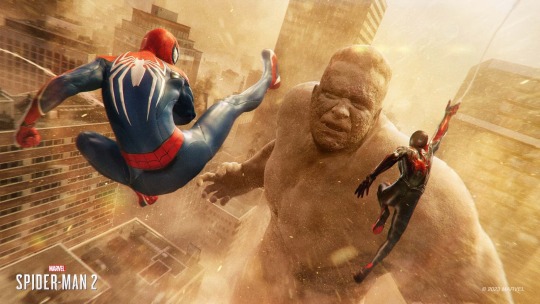
Marvel’s Spider-Man 2 How many games teach you how to play by immediately throwing you into a gargantuan, multi-phase boss battle? Spider-Man 2 does, and it’s equal parts tutorial and showcase of how powerful the PS5 can really be. Swinging into action, the Spider-Men cross the river besides Manhattan into Brooklyn to battle the latest villain of the week: the swirling, skyscraper-sized walking desert known as Sandman. The massive boss fight puts the opening action of the previous games to shame, as well as cleverly working in the tutorial amongst the story of the fight. Seamlessly switching between playing as Peter Parker and Miles Morales, the game runs through the basics of combat and mobility - swing into the fight, battle sandy clones summoned by Sandman, dodge the sandy giants’ attacks, and so on. A particularly impressive moment is when Sandman grabs Miles and flings him across almost the entire horizontal length of the map, only for Miles to slingshot himself right back - all within five seconds, no loading or slow environment generation to be seen! Peter and Miles make use of plenty of new, untested gadgets throughout the fight, such as the new Web Wings to glide on the wind and Peter’s mechanical spider-limbs popping out of his suit, learning how to use them alongside the player in an epic cinematic battle between the two Spider-Men and the largest enemy seen in the series yet!

Uncharted 2: Among Thieves The Uncharted series is known for its’ engaging narratives, but Among Thieves is a particular standout for being a great early example of how cinematic games can really get by throwing the player straight into the action. After the player presses “Start”, Nathan Drake wakes up with a bullet hole in his gut, sitting sideways in a busted-up train car dangling over a sheer cliff. In a desperate climb to safety as the train falls to pieces around Nate, the player will quickly learn the basics of parkour and movement that you’ll be using for the entire game - or plummet to their death in the beautiful albeit deadly scenery. After a quick flashback that hints at how this adventure started out, it’s back to surviving in the frozen, flaming wreckage Nate has somehow ended up in. Finally, Nate uncovers a mysterious artefact in the wreckage, presumably the source of all this fuss for the entire adventure - and it’s time for another flashback, all the way to the beginning for the story to really get started. It’s an expert combination of cinematic storytelling and intrigue (just how did Nate get into this mess?) with intense action and control tutorials that flow naturally alongside the plot - all the way back in 2009!
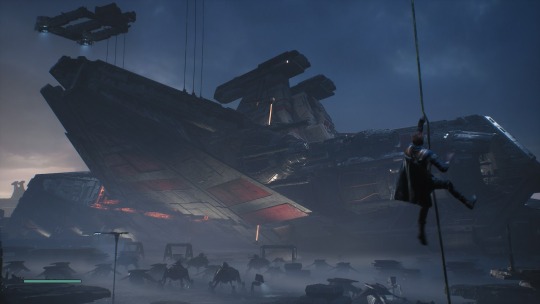
Jedi: Fallen Order Leaping and climbing across a dangerous scrapyard full of old derelict Republic cruisers, while the Empire’s spy droids and TIE Fighters constantly drone overhead - just another day on the job for Cal Kestis. As the game opens with breathtaking vistas of a vast, grim, rainy planet littered with familiar giant ships, Cal hides his Jedi training as he picks his way across the treacherous worksite. All the jumping, climbing and parkour you’ll be doing is taught very early on - the Empire sure doesn’t seem to care about workplace safety, but Cal (and the player) easily clambers across the machinery like it was a giant playground. Of course, the inevitable workplace hazard occurs as the ship Cal and his buddy Prauf are standing on falls apart, sending them sliding to their likely doom until Cal reaches out his hand and you get the coolest tutorial prompt in any video game: [RB] Use the Force. His Jedi powers revealed, the Empire quickly catches on and suddenly, Cal is fighting through a speeding train armed with a humming lightsaber and the power of the Force, effortlessly slicing through countless Stormtroopers in his path. After that taste of how strong Cal is against the cannon fodder, the player is pitted against a dreaded Inquisitor in a literally unwinnable fight before a mysterious new ship comes to your rescue - and the journey begins.

DOOM (2016) As a soft reboot of the longstanding DOOM franchise, DOOM (2016)’s opening instantly tells you exactly who the Doom Slayer is. Waking up buck-naked and chained to a bloody tomb in a laboratory, surrounded by shambling demons, what does Doomguy do? Snap the chains on his wrists, grab the nearest unfortunate demon by the face and smash it to pieces, leap to his feet, snatch up a stray pistol and aim it right at the next demon - and now the player is in control. Once you’ve cleared the lab, it’s time to grab your armour and get to work doing what Doomguy does best. Quickly, you’re shown just enough exposition to know who the important characters are and why things might be all demonic right now, but not so much that it slows down your path of annihilation. Doomguy even throws away a monitor trying to give lore, as if to say “I’m not here to listen to dialogue, I’m here to blast demons!” Through bloodstained halls and surrounded by hellish shrieking, the player sets off clearing out the first building of demons, given only the most absolutely necessary control tutorials. Finally, as the thumping main theme builds in your ears, Doomguy gives his trusty shotgun a pump as he steps onto the surface of Mars, ready to rip and tear.
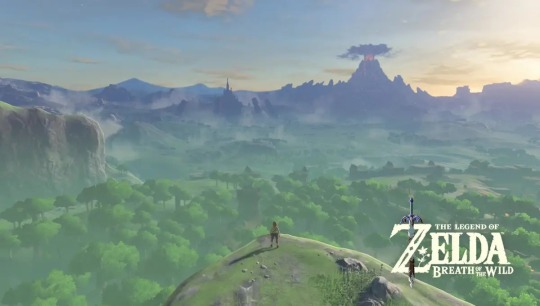
The Legend of Zelda: Breath of the Wild All these openings are fairly straightforward, but how about something a little less linear? In Breath of the Wild, the tutorial “level” is a wide-open sandbox by itself, allowing the player to explore the Great Plateau they find themselves waking up on at their own pace, in more or less whatever order they like. After you’ve left the cave you awaken in with your few belongings, the first thing you see is an old man walking away in the distance; the game’s way of telling the player exactly where to go and who to speak to, all without a single “go here” arrow. The tutorial’s open nature gives a sense of just how much freedom the player will have in the rest of the game - you can do whatever missions you like in whatever order you choose, or just wander around and enjoy the scenery at your leisure. Across the plateau, you’ll notice various shrines around you, each one granting a new power that you’ll use for the entire game, and none of them require any other shrines to be completed first. You’ll quickly learn the basics as you pick your way across the plateau - climbing trees and hills to gather resources, fighting off the handful of foes in your way, and so on with very little direct hand-holding from the game. It’s a great example of how easy it is to learn by messing around and doing things yourself, rather than reading constant button prompts and objective markers.
There’s a thousand different ways to teach a player how to play - and of course, some ways are much more intuitive and entertaining than others. Now that you’ve learned a few different kinds of good video game tutorials, you’ll probably never look at a games’ first level the same way again. Are there any other games you’ve played that did a great job showing you the ropes? Let me know! Feedback, reblogs and likes are much appreciated! Thanks for reading!
An Aussie Button-Masher
#gaming#article#spider-man 2#spider-man#insomniac games#uncharted#uncharted 2#among thieves#nathan drake#naughty dog#jedi fallen order#jfo#star wars#cal kestis#respawn entertainment#doom 2016#doom#doomguy#doom slayer#id software#the legend of zelda#breath of the wild#tloz#botw#zelda#link#nintendo
3 notes
·
View notes
Text
"Either way, I do not see myself playing any more DA games past this one."
Yikes, @the-arcane-archivist. That's quite a statement, but I understand and respect it.
I'm new to this series, so I can't reasonably say I'm anywhere close to being an expert on the lore, yet I've come across several clips that left me scratching me head (and, I won't lie, scrunching my nose a bit) because they contradicted lore I'd learned from Inquisition. Or, at least, lore I thought I understood.
I'm new to Dragon Age, but I'm not at all new to fantasy. It's been easy enough to fill in knowledge gaps.
I'm having the most trouble with the atmosphere of the game.
The word I used when asking another player questions about it was "confining." Most cutscenes and interactions I've come across are either indoors, in the dark and twisted Veil, or in a crowded city marketspace. It makes the word feel small and like there isn't room to breathe.
Another player sent me screenshots of a beautiful forest though, so it's very possible others are simply focusing on these tighter spaces.
Again, everyone has their own reasons for loving games, but a huge part of why I play them is escapism.
Inquisition immediately transports you into another world. It feels blatantly high fantasy with a massive world. It feels like you're going on an adventure with exciting and interesting new friends, and it feels like possibilities are endless.
As a totally new player with only some slight background knowledge of the series, I was excited to meet Cassandra, Varric, and Solas. I was eager to play as the Inquisitor, and while I can definitely give or take the larger-than-life hero tale depending on how well it's handled, it was exciting to know all the places that could lead. You have a lot of choices and free will to act on.
There's something about the way Veilguard's been promoted that makes it feel like Rook and the crew are just ping-pong balls Solas and the elven gods are batting back and forth on a table they've set. You can choose to bounce a little bit to the left, to the right, stay center, or roll off the table only to get put right back on it, but at the end of the day, you're still the ball in someone else's game.
While that was somewhat true in Inquisition as well, it didn't feel like it. People asking themselves whether they've been placed on the Maker's path or whether all that's happening is His will is hardly a new concept, but it never feels as though there's any active puppeteering. It's always just a question, and the Inquisitor can respond however he or she sees fit.
This time, you're up close and personal with not the idea of a higher power, but your old buddy or ex-boyfriend, Solas, who's now presented as an entirely different character (because he "acting" the whole time in DA:I). It takes the more complex questions out of it.
It takes, dare I say, a lot of the humanity out of it.
Humanity makes fantasy RPGs. Characters drive stories, and plots only help them along. There might be a stereotypical villain and a giant hole in the sky in DA:I, but it's the characters who move the story along and make it worthwhile. The game wouldn't have reached the success it had even as a long-standing franchise without Cassandra, Varric, Solas, and the other follower companions. It wouldn't have had the same success without Josephine, Leliana, Cullen, or, for lack of a better term, all the "friends we made along the way."
I can't speak to the characterization in Veilguard. The designs are a bit "meh" for me, but otherwise, they might be interesting, dynamic people. Design-wise, they definitely look a little (a lot) overshadowed by Varric and even Solas. I don't look at these characters and see pieces that I'm confident will make me remember them. The Inquisition party members seemed so distinct from each other and held their own against other games' character designs.
There's a reason I knew characters like Fenris and Morrigan already despite never having played a previous Dragon Age game, and even Alistair. I couldn't have told you much about them, but I could tell you which franchise they were from and what their names were. I long knew Solas, Cassandra, and Varric for the same reasons even if I didn't know their characters. I could absolutely tell you who Hawke was.
I'm not confident that had I not been attached to this series already that I would've placed any of these characters with Dragon Age had I not already known they were a part of it, especially with the cartoony art style.
I'm not going to dive into the art style, but I'm not a fan. It gives me Soul Calibur vibes and not in a good way.

It's the Solas angle that kills it for me, though, and I'm also in a unique position (having seen so many of the endings) for realizing I've basically already read this story in a way that was much, much more fleshed out and nuanced.
Part of The War of Lost Hearts series teeters a bit dangerously close to Solavellan fic territory to call it coincidence (particularly the second and third books, and I'm not the first to spot this). Not long before Veilguard came out, I kept thinking I wouldn't be surprised if the Solavellan ending played out like it did in those books.
I'm not going to reveal any spoilers with them, but my question's both been answered and I wish Carissa Broadbent had written the Solavellan scenes instead. I also firmly believe the die-hard Solavellans would've preferred it if they saw it, too.
There's a lot of dialogue I've seen that's made me cringe. I've seen people defend that, but there's a difference between intentionally cringey dialogue (like the bear jokes in the Jaws of Hakkon DLC) and cringey dialogue that was clearly meant to be taken seriously.
Truthfully, I'm also at the point in my life where if I don't like idea of the story, I'm not going to invest in the game.
No, I'm not the sort to judge books by their covers or games by their marketing campaigns, but I also don't have the time or money luxury anymore to be quite as patient as I used to be and just see how it goes.
I generally know I won't like a book by the summary on its cover. The same can be said about video games.
I'll be honest: I don't think Veilguard is for me. I'm glad people are enjoying it, but...
I personally have zero interest in the elven gods angle or what they've done with Solas. I loved Solas in the last game, and the idea of that all being him playing a role still doesn't cut it for me.
I simply don't want to play a game in which he's a/the villain. My patience for being "tricked" by him was already gone by Trespasser. I'm not willing to put another character through his drama.
This isn't a knock on the game at all, but I did want to make some aware since I've gotten a couple of people asking if I plan to play it.
Truthfully? No. I do not.
I don't mean it negatively or disrespectfully. I'm simply not interested in spending time (or money) on this storyline.
I also don't buy at all that a romanced Lavellan (or anyone from the Inquisition) would ever forgive him for killing Varric, nor do I think killing Varric off was a remotely intelligent move on the writers' part. They could have retired him quietly and simply not had him in future games if they were done with him.
11 notes
·
View notes
Text
Listen, I say this as someone who is an All Might stan. I fucking love All Might, he's one of my favorite characters in BNHA. But he is a fundamentally god awful character in the way that he is written. All Might is one of the most poorly written characters I've seen in all my years of fandom
And like I get it, he's a superhero in a superhero manga, so we should have some leniency with plot holes or mary-sue-ish powers, but JESUS CHRIST! This man exists solely to push plot forward in the beginning of the manga and then becomes utterly useless after the second AFO fight, but he's allowed to break every single rule set up by Horikoshi's worldbuilding, just 'cuz!
Like how the HELL is All Might a UA alumn but simultaneously his identity was anonymous until after the second AFO fight? Seriously none of All Might's classmates/teachers/any heroes he might have interned with/ANYONE WHO WATCHED THE SPORTS FESTIVAL were like "hey remember that Yagi kid who won the Sports Festival, graduated from UA and then disappeared? Well he looks exactly like this new All Might fellow and their quirks are exactly the same" not to mention that the GOVERNMENT has a registry of everyone's quirks and you have to get a LEGAL LICENSE TO USE YOUR QUIRK IN PUBLIC! You also have to file incident reports every time you do any kind of hero work!
It's also speculated that his quirk gives him regenerative healing properties, but of all the abilities we are canonically informed of when it comes to All Might's version of One for All, healing powers is not one of them. This man is missing most of his internal organs. He got his guts entirely rearranged, and not in the fun way. He literally should have died, but SOMEHOW he was miraculously able to be saved and CONTINUE HERO WORK FOR SEVERAL YEARS AFTERWARDS! His quirk hadn't completely failed him until very recently! So how is it that he could stay alive after something like that, but Nighteye had to die after receiving a similar but less intense injury, and Ingenium was permanently paralyzed (and practically erased completely from the story) after getting stabbed? With the advanced technology and healing quirks needed to keep All Might alive, there's literally no way in hell either of those two other heroes should have received the lackluster treatment they did.
This post doesn't really have a point, other than that I'm here to push my Toshinori should have been homeschooled instead of a UA Alumn and Ingenium deserved to not just be plot fodder from one arc and Nighteye being a martyr served absolutely no purpose to the story. All Might in and of himself contains so many plotholes and just complete decimations of what could have been excellent worldbuilding, and these flaws become glaringly obvious the more times I reread the manga or rewatch the anime. Like bro I love him, but his writing sucks ass
#all might#yagi toshinori#boku no hero academia#bnha#my hero academia#em rose.txt#follow for more all might meta! i love him so much but I literally hate him!#horikoshi's worldbuilding is pretty incredible but god does his writing suck shit#the entire plot of the series has more holes in it than a massive piece of swiss cheese
18 notes
·
View notes
Text
More Than Meets the Eye #8- I’m Sorry, the Domain Name thebomb.com is Already in Use
It’s been a hot minute since we last got to focus on the Scavengers- ah, the chaotic nature of comic print schedules! Luckily, we’ve got a Story So Far to remind us where we left off.
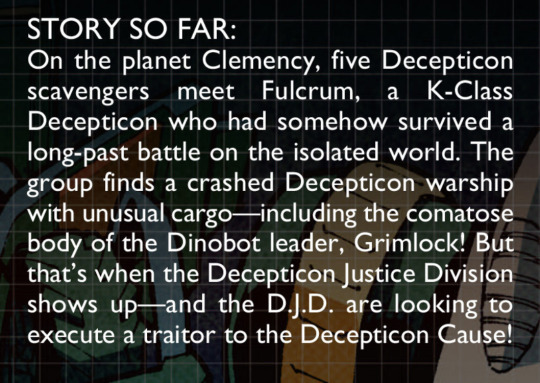
Our issue starts 10,000 years in the past, where Fulcrum is riding in a plane and preparing to drop with his fellow K-Cons. It’s crowded, there’s a guy crying in the corner, everyone’s wearing the same outfit, and no one’s got time to go home and change. How embarrassing!

Torque’s never heard of personal space, as is made apparent by his power-stance pelvic thrusting here. Fulcrum is less than impressed by this show of bravado, but there’s no time to dwell on it because it’s time to jump the glory of Megatron.

At least one of them is having a good time.
In the present day, the Scavengers are freaking the hell out, because as it turns out, it’s THEM who’re afraid of the DJD.
Krok keeps trying to reach his old squad, as if anything short of Megatron himself would be able to save them from the horrible death coming their way, while Flywheels grapples with his faith and inferiority complex at the same time.
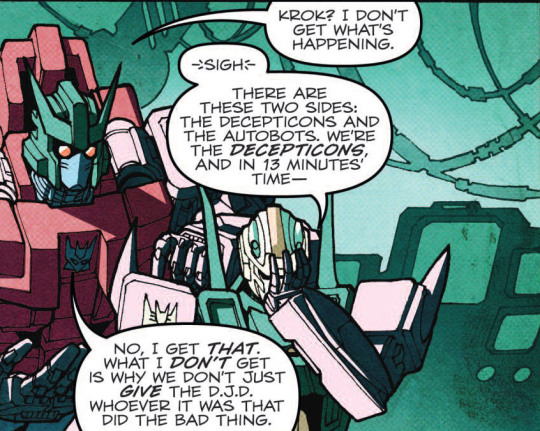
Spinister brings up a decent point, despite Misfire’s earlier claim that he’s the stupidest creature in the universe- Misfire is kind of an asshole, so anything he says involving just about anything should be taken with a grain of salt- but the problem is, nobody in their right mind would incriminate themselves to the DJD if they could help it. Also, everyone knows that Tarn’s got his head way too far up his own ass to have any sort of rhyme or reason for anything he does beyond the 𝕒𝕖𝕤𝕥𝕙𝕖𝕥𝕚𝕔.
Krok leans on his career as a military strategist to come up with a few ideas, and the boys decide to fight the DJD, after so much bitching and moaning.
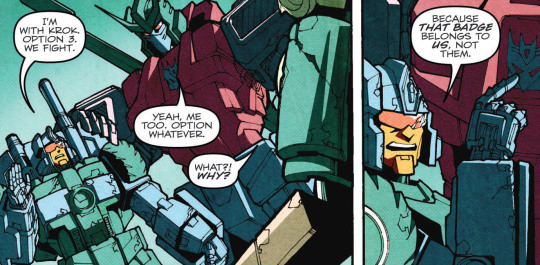
But the DJD… the Decepticon Justice Division… are also Decepticons. Crankcase, are you gatekeeping here, my dude? Because I don’t think this is an internet debate you’re going to win.
The fellas decide that they’ll do what they do best, and use what’s been laying around in the dust and blood for thousands of years to fight off some of the scariest folks in the galaxy. What could possibly go wrong?
Over on the Lost Light, Chromedome and Skids are having a secret rendezvous at the oil reservoir, in secret and behind Rewind’s back, as Chromedome proceeds to call Skids handsome. No, they aren’t having a secret love affair, but are instead going to mnemosurgery the shit out of Skids. Rewind doesn’t like that Chromedome is still doing this, but what Rewind doesn’t know won’t hurt him, surely. We’ll find out just why exactly Rewind isn’t a fan of Chromedome’s line of work later on, but for now it’s time to dig around in a hot guy’s brain.
Just kidding, it’s Scavenger time.
The Scavengers have set up a trap for the DJD, and that trap is Grimlock; still locked in his stasis pod, they’re pulling a “rigged box and stick with a piece of cheese inside” maneuver. Let’s see how this plays out.
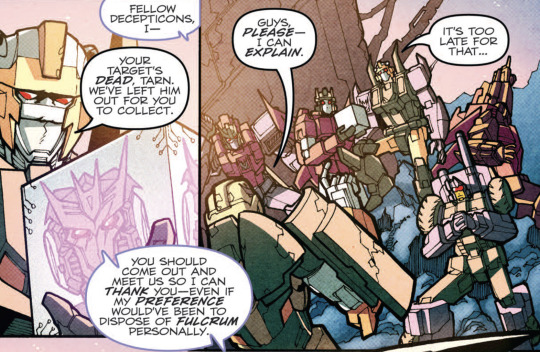
Hmm. That’s not a great start.
The Peaceful Tyranny lands, Tarn transforms, comes down the gangplank, transforms, waxes poetic about the brilliance of the Decepticon copy writers, transforms, drives 15 feet, transforms, then, after clearly stating that the big stasis pod in the middle of nowhere is a trap, opens it anyway.
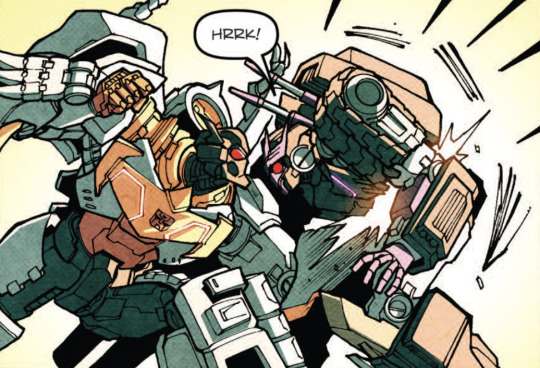
Never has a nut-punch been more deserved than in this exact moment.
Grimlock has a strong start, but almost immediately begins to flag, as he’s put down by Tesaurus. This is why we do warmups prior to rigorous exercise, people!
Misfire tries to sneak off while Tarn’s distracted whispering into Grimlock’s ear like one would a lover, but that doesn’t really work out.

Back over on the Lost Light, Chromedome’s having a time and a half trying to parse just what the hell’s going on with Skid’s head. All his memories from the last year aren’t lost, but rather destroyed, which is concerning to say the least, only leaving a need to escape. There’s also some nasty beast in Skid’s more distant past that Chromedome can see. However, it would seem that Skid’s brain took the out when it saw one and buried that nightmare so deep it’ll take multiple sticks of dynamite to wiggle it loose, so Chromedome’s leaving it where it is.

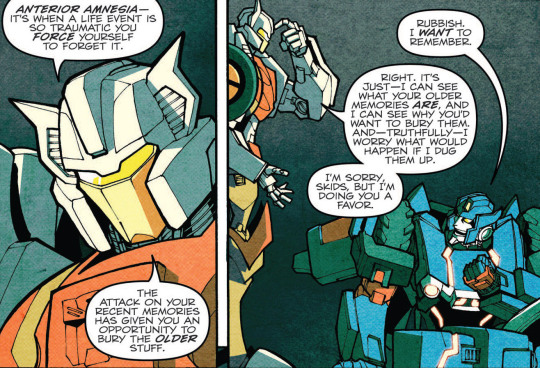
What this tells me is that Rung has no business referring patients to Chromedome for treatment, if this is how we’re meant to handle repressed memories. Remember back in issue #6, when Fort Max claimed he didn’t remember what happened in Garrus 9, and Rung was all “oh let me just call my guy Chromedome and have him stir your brain around like a martini”? Turns out, either that’s a terrible idea and Rung hasn’t paid attention to the work that half his coworkers on Kimia were involved with, or he was making an empty threat, which doesn’t seem like great practice for a therapist.
Pretty fucked up of you, Rung.
Anyways, Skids is less than thrilled by this, and demands Chromedome do it anyway, which Chromedome promptly refuses. He’ll play around with his own life, but not his friends’. Skids walks off in a huff, because I guess no one’s ever refused his pretty ass anything before, but asks a question before he leaves.

Well, I’m sure that won’t be a major plot point later on.
Let’s check back in with the Scavengers.
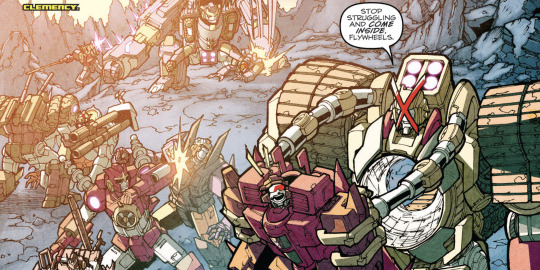
Between Tesaurus’ line here, Tarn harassing Grimlock, and Skids’ asking Chromedome why he pulled out during their secret meeting, this is probably the most sexually-charged issue of MTMTE so far.
Flywheels’ only purpose as a character was so that Roberts had a stand-in for the word “fuck” last issue. Sorry, dude, you’ve done your job. Off to the shredder with you!

No time to worry about him, Krok, because it’s time for your face mask treatment at the universe’s shittiest spa.
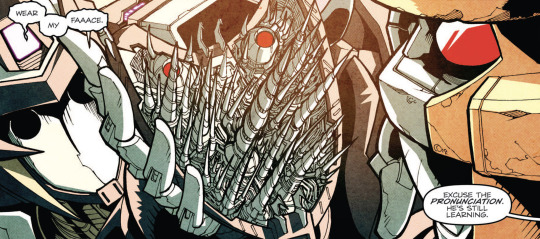
The worst part about this is the fact that he’s being held a full nelson by the DJD’s record-keeper, who turns into a fucking chair and doesn’t even have eyes. Oh, the indignity of it all.
Misfire tries to save Krok, but all he manages to do is prove that his nickname isn’t ironic in the slightest. Then he’s attacked by a dog.

That shadow being tossed towards the horizon in the background is Crankcase, who lands right about where Fulcrum’s been hiding this entire time, like the giant coward he is, as he watches these guys who tried to steal his organs get murdered to death. He runs off, and Crankcase plays to stereotype and gripes about the whole situation, until he notices something above him.
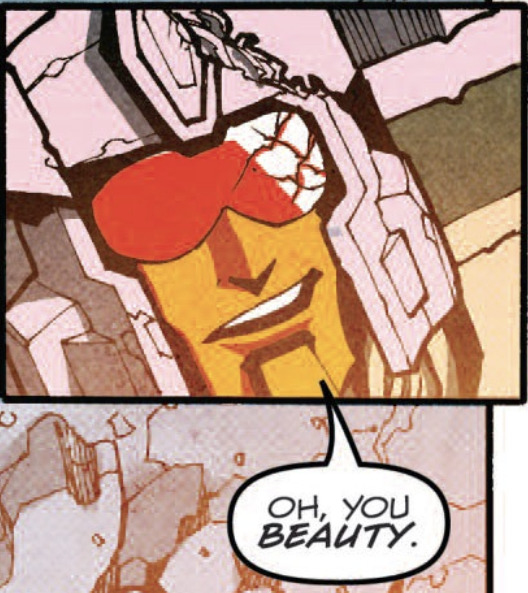
Then he immediately drops dead, because as it turns out Misfire wasn’t exaggerating when he said Crankcase would die if he ever even thought about smiling.
Over in Tarn’s soliloquy corner, he’s managed to stab his thumb so hard into Grimlock’s throat it’s literally bleeding, as he trash talks the Scavengers, calling them the “six biggest failures of all”. Harsh. Grimlock’s not contributing to the diatribe, probably because there’s a hole in his throat that’s about where a trach would go.
Then Tarn has a bit of a problem, as he’s stepped on by a robot that’s roughly twenty times bigger than him.

I guess Crankcase must be the sixth worst Decepticon, because he’s gotten himself hooked up with this massive Jaeger Cybernought, one of the many that are strapped to the back of the Worldsweeper they found last issue. It’s a big friggin’ ship, we can forgive the oversight.
The DJD aren’t impressed by this new toy, and almost immediately take it down. Tarn, really starting to get peeved off about not getting to what they actually came here to do, yells for Fulcrum to show himself. Fulcrum, as it turns out, has managed to climb on top of the Worldsweeper, and is at least a few hundred feet above them. Because none of the DJD can fly, they have no choice but to listen to Fulcrum’s little speech.
Fulcrum was forged at the height of the Decepticon Empire, when the rhetoric was more “space eugenics sucks” and less “murder everything while Megatron has weird sexual tension with Optimus in the background”. Of course, they were still hunting organic species to flex, so maybe things weren’t perfect… though it isn’t like Fulcrum minded that aspect. Dude’s a little space racist.
Spacist.
The way Fulcrum sees it, folks like Tarn went and fucked up a good thing by being all murderous and violent just because they could, unlike his good pals the Scavengers, who are only murderous and violent when it’s necessary. “Necessary” is a word that’s played with kind of fast and loose with them, mind you, but they seem like pretty swell guys to Fulcrum. They’re definitely better than the DJD.
With one last “fuck you” to Tarn, Fulcrum takes a running leap off the top of this astonishingly huge ship and finally reveals just why exactly K-Cons aren’t known for doing fear.
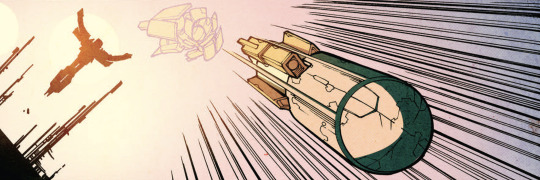
Because who the fuck has ever asked a bomb how it’s feeling?
Everyone clears the area, as he hits the ground… and nothing happens. Fulcrum is marked off the List, the Scavengers are added, and the DJD fuck off without checking that their target is actually dead so they can go find Overlord and kick his ass.
Fulcrum’s fine, by the way.

This is why we check our work, Tarn.
Fulcrum, who is, again, a bomb, is a bit curious as to what’s happened here. Turns out, prior to the boys riffling through his torso for spare parts, Spinister- master surgeon Spinister- removed the explosive charge tucked up against his robot liver. Fulcrum is amazed by this news, because it’s apparently a super hard thing to do.
Are we sure that Spinister isn’t just super nearsighted? The world’s been described as a series of vaguely hostile shapes, is he playing it safe and attacking the things he can’t figure out within a few seconds? Maybe all that hand-staring he does is to gauge how shitty his vision is on a day to day basis, and everyone just assigned him Stupid At Birth because trying to understand our friends is for losers.
Then again, we should also remember that everyone in the Scavengers is so incredibly stupid, they couldn’t figure out between the five of them that Fulcrum had been alive while it was happening. Spinister probably wasn’t gentle with that procedure since he thought he was working with a corpse; for all we know, Fulcrum’s got his sparkcase inside-out now.
Crankcase carries poor, faceless Krok over, and Fulcrum laments on the fact that Krok’s squad never turned up. Crankcase implies something ominous about Krok’s method of communication with his old squadron, then we get the skinny on Fulcrum’s whole deal.

Yes, yes, I know B’lahr 39 is a reference to Wizard of Oz actor Bert Lahr, who played the Cowardly Lion. I caught that one before I’d even checked TFWiki for interesting notes on this issue. I was a film major in college, I’m legally required to know every single bit of trivia about the Wizard of Oz. It’s the second thing they beat into you, right after watching Citizen Kane for the 87th time.
Also, how many nerds are going to be in this series? Fulcrum’s a technician, Krok’s a strategist, Spinister and 3/4 of the Lost Light are doctors in some form or fashion, Tarn’s a friggin drama kid, the list goes on.
When Fulcrum was caught, the original plan was to have him tortured and killed at Styx, a Decepticon penal colony, when plans changed and he got reformatted along with everyone else in the joint to be a suicide bomber.
If Fulcrum seems like a bit of a generic name for a giant space robot, it’s probably because it is. Fulcrum’s original alt-mode wasn’t a bomb- in fact, I have no idea what it’s meant to be. Word of God makes the claim that he turned into a leg prior to getting K-classed, but since Combiner teams have to be made in this continuity, that’s not what he came into being as. He’s got a tiddy window like Rung- something that will be more apparent when Josh Burcham is replaced by Joana Lafluente as the primary colorist for the comic run- but that seems more indicative of having minimal armor than any sort of alt.
Anyway, there’s something in the reformat to K-Con that compels one to switch to bomb mode when you jump ship- but it didn’t happen for Fulcrum, because he was so unbelievably terrified that he might have actually defied biology.
The others have stopped listening by this point, and have joined Spinister in poking the still-prone Grimlock with a stick. Misfire, in the first show of something like empathy we’ve really gotten from him, asks the fellas to help the poor guy up.
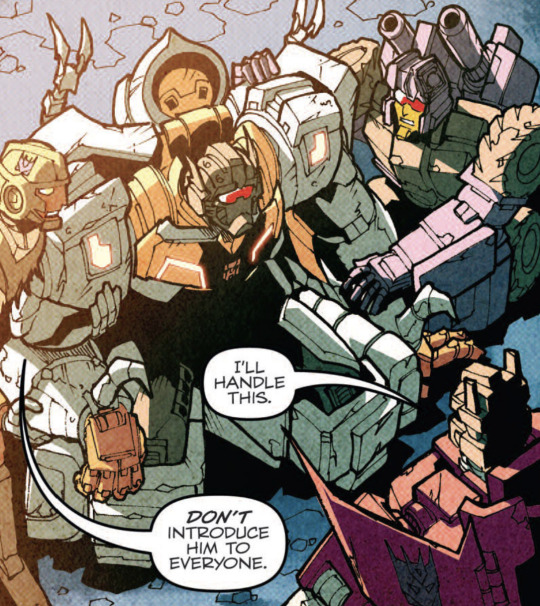
Sure, make the guy who’s a stiff breeze away from cracking in half lift the biggest motherfucker on this planet. Sounds like a plan.
Misfire does his damnedest to communicate to Grimlock that they come in peace.

Behold, the price of nostalgia!
This isn’t exactly where we left Grimlock last time he was in an IDW publishing. The last guy to have his hands on everyone’s favorite dinobot was Simon Furman, and he was a lot more well-spoken there. It would seem that no one got out of Garrus 9 unscathed.
This development is a bit of a problem for the Scavengers, who now aren’t quite sure what to do with a infamous warrior-bastard who’s mentally regressed to the point that he’s got to think about what his own name is. To be fair, most people wouldn’t know what to do in that sort of situation. Doesn’t help that the guy who usually has the braincell is currently passed out from face-based puncture trauma.
Misfire decides that they’ll take Grimlock along with them for collateral, and everyone is so impressed by him actually planning something out, they forget to think about the logistics of housing a whole entire T-Rex.
The guys, I guess just leaving Grimlock and the unconscious Krok in the dirt, go to find what’s left of Flywheels- basically the hips down is still intact. After a few kind words, the final rites are performed.

You will be missed, Flywheels, clearly.
You never see the Autobots resorting to cannibalism like this. Maybe they’re just better at making it not look like a vulture swarm.
Many, many months later, long after the Scavengers have left the planet of Clemency, a lone figure visits what’s left of dear Flywheels- it’s the Necrobot. That’s right, the Robo-Reaper is real, and it looks like he’s been busy.

…Spoilers, Necrobot! Come on!
After the story proper, we get a Meet the ‘Cons page. Let’s take a gander, shall we?
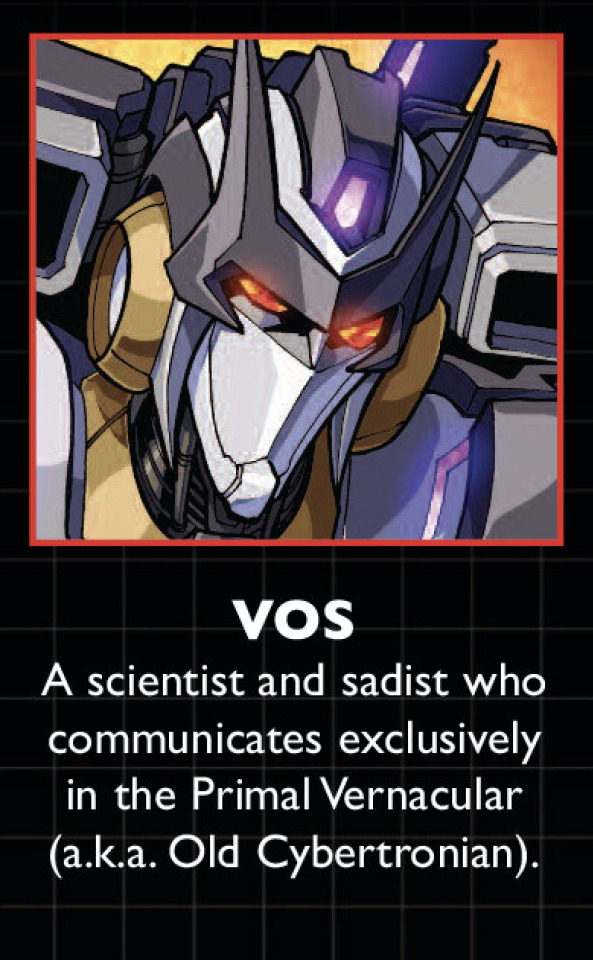
No.
NO.
NO!
I draw the line at this motherfucking sniper rifle having a college degree. What possible scientific field of study could he possibly-
It’s ballistics. He studied ballistics, didn’t he?
You know what? Fuck this, actually. See y’all later.
…Fuck you, Vos.
60 notes
·
View notes
Text
What’s Missing in The Rise of Skywalker or What I Think Star Wars Needs in Order to Work…
This may be pure conjecture on my side… But there’s one thought that’s not letting me go these days.
We have shredded Episode IX to pieces by now and we all know its plot holes and massive problems with character development, coherence, morality etc.
But I’m realizing that there is something that Star Wars has always had at its center… and I believe that without it, it simply cannot work.
The Father Figure.
Remember, the central sentence (and one of the most iconic film scenes ever) is the infamous “No - I am your father.”
So let’s face the saga from this point of view.
The Phantom Menace is not a masterpiece of filmmaking, but a decent film, with an interesting story and a lot of intriguing characters. It works well as a solid introduction to the prequel trilogy.
At its heart we find Qui-Gon Jinn. Gentle, cunning, compassionate and rebellious, Qui-Gon is the ideal Jedi if there ever was one. To Anakin, the fatherless child, he is the first father figure he knows, the first person who is an advocate for him and pleads his cause; not that his mother wouldn’t, but she was powerless to do so. Qui-Gon also has the broad-shouldered, tall frame that will later become one of Darth Vader’s trademarks.
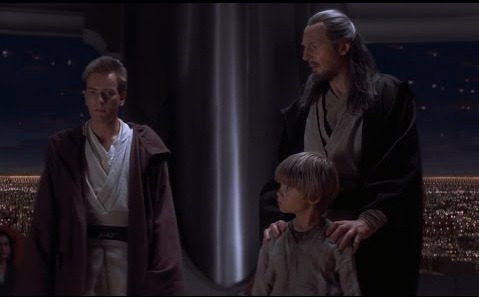
Attack of the Clones is one of the weakest, if not the weakest Star Wars film of all. And I can’t overlook the fact that there is no father figure at its center.
We get to know Jango Fett, Boba’s father, who is however not a main character: his presence is important for the course of the plot, but not the impact of his personality itself.

We also have an interesting insight in Anakin’s relationship with Obi-Wan. It takes only a few minutes for us to realize that these two are not on the best of terms: Obi-Wan is too immature and inexperienced for the task he has to shoulder, too strict in his adherence to the Jedi Code (possibly due to the other Jedi’s critical eye on them), and Anakin is more powerful than he is despite his youth. As a result, young Obi-Wan does not have much, if any, influence on the events of the story. He may be a good Jedi but as a father figure for young Anakin he is not suited at all.

Revenge of the Sith sees Palpatine taking over the rule as Anakin’s master: it is interesting that before this moment, he used to refer to the Anakin as “Son”, another way of subtly manipulating the young man who was in need of a father figure to look up to.
The film is excellently made and, very fittingly, the unraveling of a human tragedy. Palpatine is the most powerful and also most horrifying father figure imaginable, who offers Anakin enormous power to a terrible price: the loss of everything he ever was.
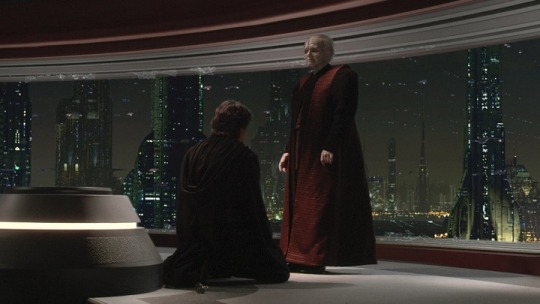
A New Hope is a very good film in many ways and for a lot of good reasons, not least due to the elderly Obi-Wan (Ben) Kenobi. He is the one who introduces Luke to his powers and explains him - and also us, the audience - the nature of the Force. Without him, we would be dealing with a good but not remarkable science fiction story. The element of magic is introduced by the Jedi who is a mentor to Luke, another young man who longs for a father figure in his life.
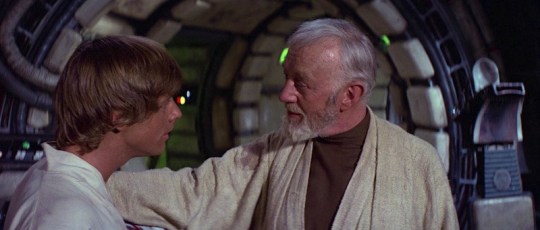
To put it mildly, The Empire Strikes Back rocks! I still think of it as the best Star Wars film ever made. It contains everything a film needs to be compelling even on seeing it again and again.
And who is at the core of it all? Darth Vader, the Dark Father, the Evil, Unknown, Malignant Father. Vader is at the height of his power in the film which from his point of view is the hunt for the son he thought dead and now wants to bring at his side at all costs. Vader is terrifyingly powerful throughout the film, he dominates every scene.
Not coincidentally, we see him in his meditation chamber once where he reminds of a king sitting on his throne.

Return of the Jedi is not bad per se but it is commonly (and in my opinion rightly) seen as the weakest of the original trilogy. Yes, I know, the Ewoks are annoying and in Jabba’s palace we already have too many Muppets - it doesn’t work when you want to make your film more child-friendly and at the same time to tell the culmination of a family drama.
But again, what I miss here is a central figure. We see Palpatine holding Vader’s leash, until he is at the last moment defeated by the father desperate to save his son. It is an act that costs him his life and makes Vader and his redemption heart and soul of the story.
But until that moment, we have Palpatine at the center of the plot. Thus, there are two father figures. And I can’t help but noticing that the fact is a little irritating in itself. Similarly to Attack of the Clones, Return of the Jedi seems to waver when it comes to deciding what it is about, what the actual, all-encompassing arc is.
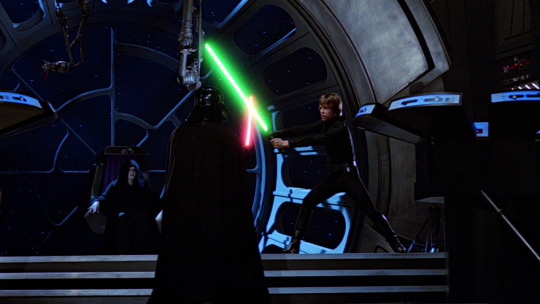
The Force Awakens: Han is thirty years older now and a father figure himself - to a son who felt abandoned by him. Han dominates the key scene: his son is unhinged and conflicted and despite his power, he doesn’t have the events under control.
Han’s decision to give up his life to save his son’s soul is a last, desperate act born from love which parallels Vader’s. Even if at this moment we do not yet realize that he will succeed in the end, we are aware that something momentous has happened on the fatal bridge: an event that was built up for many years and will have enormous repercussions on everyone involved.
Not surprisingly, Han also felt like a father figure for Rey, the other protagonist of the sequels.

The Last Jedi sees an aged Luke Skywalker in the role of the wise old mentor which once was Obi-Wan’s. Though his attitude is not exactly fatherly, Luke is heart and soul of the story. His wisdom, his courage and also the admittance of his failure push the story onto its tragic but heroic ending.

The Rise of Skywalker is disappointing on many levels, but thinking about it again, there is again that certain something that I miss most.
Yes, the Father Figure.
Palpatine is but a creepy old shadow and is not even acknowledged as kin by Rey.
The central and most moving scene is, again, a meeting between Han and his son, finally reconciling.

For good measure
Rogue One is the story of Jyn’s father Galen, his plans for the Rebellion and her daughter living only to fulfill them. Though sad, it is a good and convincing story.

Solo is nice to watch but it does not work as well as Rogue One. My guess is that focuses too much on action and not enough on character development: the film does not make clear enough that Beckett is a father figure for Han, and that it is significant for his personal development to leave him and his mindset behind.

The Clone Wars has Anakin’s relationship with his padawan Ahsoka at the heart. Though from their age difference he is more like a big brother for her, differently to the other Jedi he is protective, respectful and listening with her. Anakin’s attitude proves over and over what a good father he would have been had he had the chance.
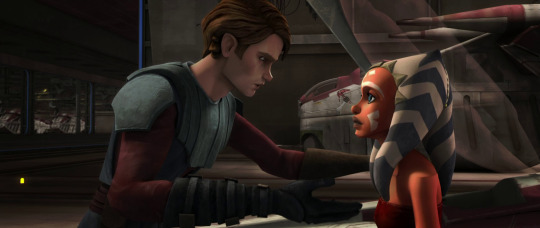
The Mandalorian works excellently and it has, again - need I say it? - a father-son relationship at its core. Despite his previous cut-throat demeanor, Dindjarin always makes his little protegee feel safe and lets him develop his powers in his own way and time. In return, the child is his way back to humanness.
This is the most heart-warming and perhaps until now most convincing father-child-relationship we have ever had in the entire Star Wars universe. Is the series so good for its action scenes? I’m not denying that. But that’s not what the story is about: it’s about what makes a good father, even if you are everything but a saint.
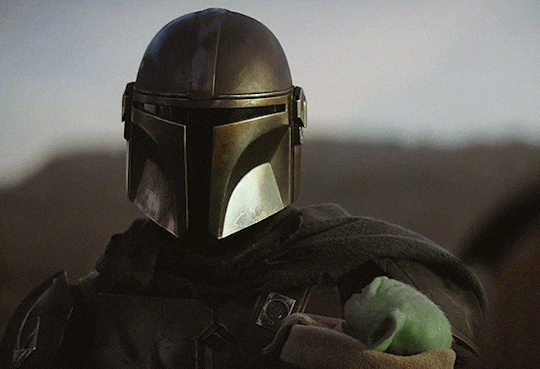
And that what is most bitter for me about The Rise of Skywalker.
Ben Solo did not get to be the father figure I was certain was his ultimate fate to be: he was Vader’s opposite in so many details, down to his facial figures. Darth Vader was a most impressive villain but a nightmarish father. Kylo Ren never was half as convincing as a villain, which to me made it logical to assume (also since we get to know Ben Solo as an emphatic, caring person) that he was meant to be a good father and his failure came from trying to be something he wasn’t meant to be in the first place.
Anakin had damned himself with the carnage of the Jedi padawans; and in The Last Jedi the Canto Bight children, one of which is Force-sensitive, had been introduced. By becoming the Good Father his grandfather never had the chance to be Ben would have found redemption and purpose. And Rey, having been abandoned herself, would have been an excellent mother figure. (Apart from that, I don’t doubt that Adam Driver could play the role of the affectionate, protective father hands-down.)
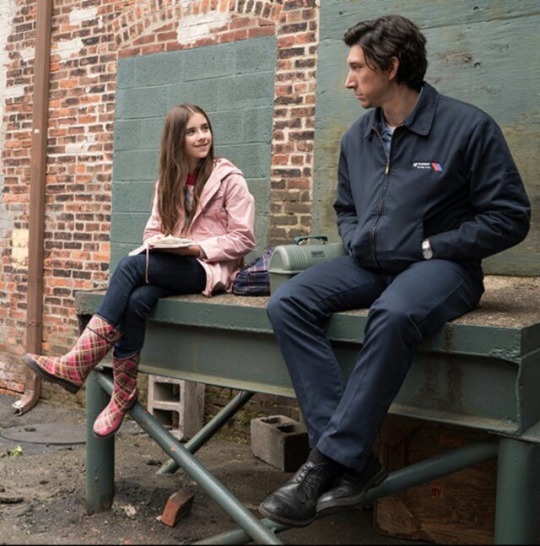
It is still a mystery to me why this obvious route was not taken by the filmmakers. Letting the last of the Skywalker blood die without having him fulfill his destiny was the bleakest route the story could take.
I don’t know what’s in the cards with Rian Johnson’s trilogy. But I haven’t given up hope for the saga to finally give us the happy, united family that I am positive always was meant to be at its core.
Tragedies and cautionary tales are well enough. But I believe that after all of the drama, we ought to be in for some joy and fun at last. 😊
#star wars#ben solo#darth vader#the mandalorian#episode IX#the rise of skywalker#adam driver#skywalker family#rian johnson#anakin skywalker#obi-wan kenobi#palpatine#luke skywalker#han solo#qui-gon jinn#boba fett#jango fett#the last jedi#read more#sw
128 notes
·
View notes
Text
Media recommendations for people who can’t quite fill the hole Umineko has left behind (not including And Then There Were None as it was obviously a massive piece of inspiration for the series in the first place)
Zero Escape’s 9 Hours 9 Persons 9 Doors -- mystery escape-the-room game that starts with nine people getting kidnapped and put on a boat that will sink in 9 hours. Each one of them is given a bracelet with a number on it; the goal? Find the door that carries a 9. I assume most people that have played Umineko have at least HEARD of Zero Escape. This is that sign telling you to play 999 if you haven’t yet.
House of Leaves by Mark Z. Danielewski -- metafiction story that uses many different formats to construct an entire universe. Like Umineko’s metaverse that allows you to look in on the events of the game as a separate world, House of Leaves utilizes footnotes to construct three different storylines to separate the worlds of the book.
Shiki -- psychological horror that follows a town where people begin to die at exceedingly high rates due to an unknown virus. I can’t say much more than that at risk of spoiling it but if you like the “gray morality” aspect of Umineko and really loved that you ended up cheering for Beatrice halfway through the story, Shiki is probably up your ally. I will say that Shiki was kind of boring for me until about Episode 12, but once I hit episode 12, it really took off.
IT by Stephen King -- Most people here have probably seen the movie by now. Full disclosure; I’m about halfway through IT and have been halfway through IT for like 3 years now. I’ll finish it.........someday. But the narrative also reminds me a bit of Umineko’s in the sense of “two entirely separate worlds that end up colliding about halfway through the story to make a complete plot”.
Memento by Christoper Nolan -- See what I said above about the separate worlds coming together to make a complete plot? That but even more intensely. I don’t want to say much more about this other than “watch it” because it’s one of those movies that’s a lot of fun to go in blind.
Magpie Murders by Anthony Horowitz -- not gonna lie, this book wasn’t really my cup of tea in the end but I think that people that like the whodunnit aspect of Umineko and enjoy Agatha Christie, this is right up your ally. You get a whodunnit inside a whodunnit! What?! Two mysteries for the price of one? AND you can solve both -- solving the whodunnit inside the whodunnit gives you clues to figuring out the big mystery!
This list may be consecutively updated as I think of more things but I’m super tired so it’s time to go to bed. I hope this helps you fill that seacat-filled void in your heart. I’ve heard Fata Morgana is also worth checking out but I’ve yet to play that myself so I can’t vouch for it myself!
97 notes
·
View notes
Text
Audrey and the Dark Revival, chapter 2: Open Loop
Audrey and the Dark Revival is intended as a sequel series for Bendy and the Ink Machine. May the actual sequel come out soon and completely blow mine out of the water.
This one is where the plot gets real.
Also, I’m using a few of @mwolf0epsilon‘s fantastic monster designs, and plan on using more of them in the future.
---
When Allison removed Audrey’s blindfold, they are on separate sides of a metal door. The door had once been for a now-defunct meat freezer in an industrial kitchen, but it was now defunct, as the lack of cold and the massive, albeit boarded-up, hole in the door told her.
“Sorry about that,” Allison said, “It’s hard to trust anyone around here. I’d normally have just kept an eye on you and let you be, but you have no idea how valuable humans are down here. I really couldn’t just let you go. If you could help us, I would owe you the world. Of course, the fact that you’re on Nathan’s side could cause some challenges... but let’s at least try to work something out.”
“Woah, wait...” Audrey said, “I’m not on Nathan’s side. I’ve been here half an hour and I already regret coming. Nathan and I aren’t on good terms... Anyhow, what I really want is information. What is this place? What are you? And why are humans so valuable?”
“For a long time, I didn’t know what this place was either. Then, a few years ago, I found an audio log from Nathan Arch explaining it. A man named Joey Drew made this place. It’s a representation of how he feels about his failures as an animation visionary- that’s what most of this place is, anyhow. He didn’t create the people. They’re people he murdered, or who got poisoned. Part of the reason this place exists is as a storage device for them. A lot of the space isn’t his creation, either. This place used to be a lot smaller, and after it had been around a few years, Joey Drew put it in a time loop. The only reason I escaped it is because the ink demon chased me into one of Nathan’s areas. The new areas- they aren’t affected by the loop!” Allison’s face brightened considerably. “For a while I thought that the spell was breaking. That it was the world opening up to us! Tom told me otherwise, but I was sure.” Allison darkened again, and Tom laid a hand over her shoulder. “Then, over time, Tom and I kept running into worse and worse monsters. The world has expanded... but it’s also gotten darker, and more crowded. So, Tom and I took to doing what we’ve always done- survive, and look for solutions. We found your father’s lair, complete with new monsters coming out of it. But no toon could ever get into it- it’s defended by ink canons made to melt any other creature of this realm who comes close. And since there were no humans around who were up for the task... since then we’ve just been surviving. Waiting on a hero. Audrey, will you help us to get your father out of here before he makes this place any more of a nightmare?”
Audrey was overwhelmed. “I- I’d love to. But I’m just a random civilian. I don’t know how to fight monsters. I don’t know the lay of the land.”
“Well, you’ll have to learn that if you want to survive here, whether you want to be a saviour or not. I can teach you to fight, and the names of monsters.” Tom whispered something in Allison’s ear. “And there is another human in this realm. If you won’t be our hero, maybe you can convince him to be. He’s proficient at combat and knows the place like the back of his hand!”
Audrey was silent for a while, weighing her options. A part of her didn’t see much other choice. While she had no reason to believe these strangers, they were clearly strong, and the world was clearly dangerous, and she wanted them on her side. And if they were telling the truth and could lead her to Nathan, all the better. “I’ll do it,” she decided.
“Excellent,” Allison beamed, smiling excitedly, and they let her out. After gearing up in the industrial kitchen that they’d made into a base (complete with cots and even a fish tank, Audrey noticed), they headed out. Allison led- she clearly knew the lay of the land. Along the way, she pointed out a number of monsters. She pulled Audrey away from a ledge, warning of the balls of wool, horns, and hooves that might ram her over the edge. From a safe distance, they witnessed a huge, quasi-canine abomination with hooks for hands dragging an exhausted, monkey-looking abomination into a puddle of ink, in which it dissolved. Allison called these creatures “rammers,” “catchers,” and “pipers” respectively. Along the way, there were also opportunities for Audrey to practice using her shock powers with Tom and Allison as back-up. She was getting quite proficient.
Finally, they arrived at what appeared to be a storage area for amusement park equipment- “Bendyland,” as Audrey learned about it from tapes. Just past a roller coaster ride was some sort of ethereal boundary. Their side of the boundary was the some dark, gloomy blue-toned white that everything in this realm had been. The other side of the boundary was somewhat better lit and sepia-toned. “That’s the area affected by the loops,” Allison explained. “And Henry- the other human- will be passing through there.”
“Great,” Audrey replied, clicking the button of a tape recorder that she’d found sitting on a workbench.
The death of the Great Bertrum Piedmont was a tragedy, truly. He was a great boss. But I’m not so sure about sticking around. Seems like there’s been an awful lot of murders among the Bendyland staff since then... and yet the rides keep gettin’ made faster than ever. It’s like they build themselves after the lights go out. I have half a mind to go pokin’ around... but I don’t have that much of a death wish.
Suddenly the roller coaster began to rattle. A piece of the tracks disconnected and swiveled towards the trio, and a duck-shaped cart hurtled towards them, sending them scattering to avoid being crushed. The duck carts- approximately a dozen of them- split off in different directions, going to various spaces in the vast, area-consuming roller coaster. Tom found a round, foundational bolt, and barked to get Allison’s attention before smashing it with his metal first. Allison turned to Audrey, who was attempting to shock a duck to little effect. “Audrey!” she shouted, “find the foundational bolts!”
“What?” Audrey yelled back, dodging out of the way of a duck.
“These!” Allison yelled, stabbing one opposite to the one Tom had destroyed. The entire section of roller coaster collapsed, falling onto another and taking it out with it like dominoes.
“Okay!” Audrey called out, before returning to the weave of dodging ducks, never staying in any one place too long, and finding foundational bots to takeout with her lightening powers. Her power’s range was very useful, but she still needed to constantly be on the move. When the carnival music finally stopped, Audrey looked around her to assure that there were no more pieces of roller coaster left to destroy. Then, she collapsed, first sitting, and then sprawling out on the floor.
Allison rushed over. “You okay?” she asked.
Audrey nodded. “Tired.” She wasn’t used to this kind of activity, but took solace in the fact that even Allison and Tom seemed pretty worn out.
“Well, you’re in luck. A break is the next thing on our to-do list.” Allison helped Audrey up, and they went over to a little selection of carnival games. “Henry will come over here. It’s a part of his loops. It could be five minutes or days. In the meantime, this room has no monsters, so we might as well relax. Wanna see if you can beat me at this shooting game?”
With that, the three of them spent the next couple hours playing games and hanging out. “Wait-” Allison said after Audrey had shared a little story, “You have memories of the outside. You can tell us about the outside!”
Audrey reached for Allison’s wrist. “Well, sure, I-”
As soon as Audrey made skin contact with Allison, Allison’s face went into blank shock. Audrey’s first instinct was to look behind her, but there was nothing there.
“Allison? Allison?”
“Give me a moment. Oh my God. I remember everything.”
“Sorry. Nathan gives me powers like this. He’s probably trying to sabotage us somehow.”
“How could this possibly be sabotage?” Allison beamed, smiling widely. “I don’t know anything about Nathan. Maybe he’s stuck and wants to escape. But this is great. You could work your magic on Henry this way! Speaking of which- over there!” Allison pointed to the entrance of Bendyland.
Through it, a man emerged. It wasn’t the hero that Allison had promised. The man looked to be in his mid-fifties, and was fairly athletic but nothing special. More notably, he was stained head to toe in ink, and had an extremely bored, weary expression on his face. He saw the trio, but ignored their presence entirely and plodded over to one of the games.
“You first, Audrey" Allison whispered, “He’ll think that we’re a hallucination, but he’s never seen you before. I guess I should tell you now, though- he’s not the man he once was. These time loops have damaged him greatly.”
Audrey headed over to him and the other two followed. Allison grabbed his arm, which Henry still didn’t react to, simply trying to play the game despite Allison hanging off of him. Audrey touched him, and he spasmed out, gasping, but afterwards went right back to his game.
“Henry, this is not a hallucination. Come with us,” Audrey said.
“Yes you are, Allison,” Henry sighed, still looking at the game, “you aren’t from this part of the loop.”
“Henry. You’ve never seen me before,” Audrey said.
Henry turned to her. “You’re right. I haven’t seen you. Sorry, my memory’s a little... spotty, although after what you just did to me...” Henry drifted off into space. “Maybe you aren’t a hallucination. So... what do you want?”
Considering the revelation he’d just had, the man’s voice conveyed considerably little emotion. Audrey chose her next words carefully.
“Henry, we can’t get you out of the studio- not yet, anyhow. But we can get you out of this time loop if you come with us. And we need your help.”
“Henry, come with us and we’ll save Boris" Allison added, “We know a way into chamber he’s being kept in.”
Henry’s eyes immediately lit up. “I’ll come!,” he said, showing the first signs of hope and life that Audrey had seen in him. “If we can do that, then I’ll know this is real!”
#Bendy and the Ink Machine#Audrey Arch#Henry Stein#Allison Angel#tom boris#Audrey and the Dark Revival#my fanfiction
2 notes
·
View notes
Text
Halo and the Burden of the Extended Universe
Halo, as in the initial trilogy of games one through three, has been about one man, known only by his rank, traveling to exotic alien superstructures hanging in deep space, traversing their surfaces on foot and in a variety of human and alien military vehicles, and mowing down literally hundreds of enemies per level. Throughout that trilogy, we’re supposed to believe that these aliens, the Covenant, pose a great risk to all of humanity. We’re told, by way of the instruction manuals and some NPC chatter, that these aliens have pushed our own species, at the time a massive space-faring empire, back to the singular planet of our birth.
In all three games, we just barely make our way to the latest superstructure, clawing our way there against what's said to be insurmountable odds. We're constantly told that we're low on resources, low on time, we barely have a foot in the door while the Covenant have already made their bed. And yet, every single game, we win. Effortlessly. Constantly.
And not only do we win, but we prevent the total annihilation of all life in the universe no less than once per game, sometimes more! Untold hordes of enemies fall at our controller-wielding fingertips, but somehow we're meant to accept that this one is our last chance, for real, we swear. Still, problems come and go at the whim of an inattentive scriptwriter, built up to be the most important thing we've ever seen, left perfectly resolved at the end of a 20-minute level.
In every game, the goalposts are constantly shifting, pushed further and further back by writers who realize, sweat on their brows, that they've started with the destruction of all life in the universe and have to somehow amp it up from there. For three games.
To put it mildly, they are not successful.
What do we have to be afraid of? Not the Covenant, because even the worst weapons we have available to us can tear them apart. All life on Earth, the last bastion of our species, is put at risk a full three times over the course of two games, and every single time we, as the protagonist, turn our back on the problem and are promised it will be solved when we aren't looking. If the Halo rings are fired, all life in the universe dies! Except when it was fired in Halo 2 and only sent a standby signal before being deactivated. Except when it was fired in Halo 3 using a never-before-heard-of "tactical pulse" that is at perfect odds with everything it was stated to do in all three games.
There's no threat that sticks, no threat that matters. Everything the games have told us to be afraid of are continuously revealed to be utterly inconsequential. Even the moment-to-moment threats become routine, the moment-to-moment losses, unnoticeable. How many times have you gathered a squad of friendly Marines only to lose them all in the next gunfight? Well, don't worry, here comes a Pelican with four new ones, no questions asked. Yes, we're running low on fuel and men and supplies, but here you go Chief, you're special.
But why are we special? Who is The Master Chief? We know some things, but not a lot. We're a supersoldier, a Spartan. We have a ship's AI in our head who tells us what LZs to clear and does all the talking for us. Across three games, approximately thirty hours of gameplay, our main character has a mere sixty-eight lines of dialogue, and most of it doesn't pass the five word mark. Cortana, in comparison, has nearly six hundred spoken lines. Our hero is characterized only by lines like "boo," "green, sir," "I need a weapon," "understood," and "we'll make it."
Truly, a fascinating and deep character to go down in the annals of gaming history. A man brimming with all the personality of a cardboard box, all the empathy of a brick, and all the motives of a potted plant.
And yet, every Halo fan out there will tell you how cool he is, how haunted by his past he is, how deeply he feels the loss of his comrades, and how much he cares for his tiny blue Garmin.
Why? We played the same games, right? With all the same plot holes and haphazardly shifting priorities, the miniscule cast of named characters that never do anything to extend past their paint-by-numbers archetype? What are they getting out this that I haven’t?
Well, they read the books.
To them, Halo has an excuse. There aren't any plot holes, none at all, because you can just read this piece of licensed fiction to plug it. Are you still uncertain, well over a decade after the fact, just how much time passed between Halo 2 and 3? There's a graphic novel to answer that for you. What about the Arbiter, why didn't he stick around to try to form a proper treaty with humanity after the end of Halo 3? Read the book to find out. Okay then, the Flood invasion of Earth, how'd that get cleaned up so fast? Don't worry, watch the animated short.
This isn't how storytelling works.
You don't get to present a player of your game, a buyer of your product, with one third of a story and then tell them the rest exists as multiple books. You don't get to ignore key plot points that would bring your story together just so they can be sold off years later in a different medium.
External media, should your property have it, should be to expand on things the primary property has no room for. Hinted-at background events. Formative character experiences. Something tangentially related that still ties in to the main story. If it's really that important, tell your writers to make room for it in the main product.
Halo has the room for it. Each game will probably take a first-time player around ten hours for a first playthrough, and far less time on subsequent runs. These games are short, but they attempt to tell a story many times larger than they make room for. So make more room. End the focus on getting players in and out in a single weekend sitting. Let your characters talk to each other beyond exchanging stiff one-liners in cutscenes. Stop making every level a bombastic, breakneck setpiece and give the story room to breathe, to actually be told. If it’s the end of the universe we’re dealing with, surely you can spare us more than nine measly levels? Let us actually see the larger situation rather than being told about it. Do you really think Halo fans would complain about a campaign taking fifteen to twenty hours to beat? They love Halo, they want to spend time with it. Capitalize on that, and take the opportunity to finally, actually tell a story with all the parts in it instead of just a third.
Which brings us, finally, to Halo: Reach.
Certain Halo fans, largely the same group of them that defend the poor storytelling because “it’s in the books,” have a reaction to Halo: Reach that can best be described as ‘vitriolic.’ They don’t like it. Why?
Because it’s not like the book.
You see, while Halo: Reach came out in 2010, a book by the name of Halo: The Fall of Reach came out some months before the first Halo game in 2001. They are both about the same event, but with quite major differences. This caused quite a lot of contention at the time of Reach’s release, mainly from the part of the fanbase that believed they were going to get a one-to-one retelling of this book in videogame form.
They didn’t get that. Halo: Reach is an original story that tells the tale of a world’s final hours and one team of elite supersoldiers as they attempt to do anything they can to help delay the inevitable end. It’s not the most compelling story ever written, or even the most compelling version of that story ever told, but it’s effective. Even though we’re dealing with the imminent destruction of an entire planet, the story manages to stay small. Reach’s ultimate destruction is a common piece of wall graffiti or NPC combat barks, so the ending is known, leaving room for smaller objectives to take the spotlight. Rescue civilians trapped behind enemy lines. Delay an invasion force to buy evacuation efforts another hour. Clear the skies so supplies and medivac can go out.
Halo: Reach has almost no connection to the series at large, and it’s quite the breath of fresh air. As a prequel, its ending is a forgone conclusion, but it does what it can with the time it has. The messy, convoluted politics of Halo 2 and 3 are far in the series’ chronological future, letting you fight two enemy factions at once for the first time in the series, away from the plot point that sees them at war with each other. The end of the universe isn’t constantly being dangled over our heads for the third time in as many games, so the characters have a chance to sit down and swap banter, tell us who they are. They aren’t anyone too terribly compelling - Bungie still hadn’t quite figured out character writing - but they’re tested archetypes played well enough for the story’s demands. The threat is known and static, the stakes grow higher by way of the ticking clock drawing us ever closer to the planet’s inevitable end. There’s no faffing around with “trading one villain for another” because killing the first one would have ended the story too quickly, so a new one has to show up with no lead-in.
Even at the very end of that original trilogy, Halo’s story was too big for the time Bungie gave it. Its own plot points were shoving at each other, jockeying for position, knocking parts off themselves in an effort to fit into nine half-hour levels until all that was left were fractions of what you’d need to find in the books afterward.
Reach suffers from its own short length, but not in the same way. It suffers in that you can point to the characters and they say needed more setup, more time with each other, maybe another level or two here or there to really draw the relationship out. It suffers by pushing a little too hard at the “imminent end” angle, hurrying you through and skipping over hours of in-world time that probably could have been their own level.
But surely even the superfans saw that this was preferable? That a standalone story was the best way to go about things? Surely they understood that attempting to simply recreate the book would have ended with them not seeing any of what Bungie came up with for this new game? There’s a lot to like about Halo: Reach, and a lot to do in it that you can’t do in any of the other games. Surely even the most fervent defenders of the extended canon ended up coming around and being able to separate the two for what they both were on their own.
Of course, that’s not what happened. See again, ‘vitriolic.’ And so here we are at the question this whole thing has been building up to. When a company leans as hard into external supplemental media as Bungie did for Halo, is it then obligated to play by the rules and plot points outlined in those external entities? It’s a tricky question, mostly because up until that point, Bungie had gone ahead as if every book and animated short and comic and webisode was one hundred percent canonical. The reason superfans tolerated those gaping plot holes in the games is, again, because they weren’t holes at all when paired with their companion media. So now, in the far-past year of 2010, Bungie has suddenly decided that one of those sacred tomes of external knowledge is incorrect.
I think the easiest answer would have simply been to...tell the proper amount of story in the first place, but I guess it’s a little too late for that, especially now.
So what, then, is the obligation put forward by such a slavish devotion to external storytelling? Were they wrong to do something different? Were they right to forge ahead with something new for the benefit of freeing players who had never read that book and any other related to it from the web of multi-author canon?
I’d say they made the right move. Let’s talk about Star Wars.
Star Wars and Halo share many a talking point, the most obvious of which is just the sheer amount of additional stories they have stapled to them. Great news for fans who are into it, but terrible news for the actual IP holders. All they do is get in the way when the primary vehicle wants to expand. Disney felt it more than Bungie ever did, but Bungie felt it first: cut away the myriad stories clogging up the canon or you’ll never make anyone happy. Try to appease the superfans and get burned by not touching on every single node of criss-crossing plot webs that is the result of decades of overlapping stories by as many authors, while alienating newcomers by being forced to pay lip service to concepts and characters they’ve never heard of and have no attachment to.
Disney made the right call, and so did Bungie with Reach. What came next in Disney’s case isn’t relevant, and Bungie washed their hands of Halo entirely afterwards.
If your story cannot survive without the propping-up of half a dozen pieces of external media, you have failed to tell a good story. If your answer to questions about this story is to tell the asker to read a book, you have failed to tell a good story. I understand the appeal of that expansion, of being able to have a celebrated setting grow and reach new places, but it shouldn’t come at the expense of the setup. The world has to exist before it can be expanded upon. The story needs to be in place for its offshoots to grow. And that’s what Halo fails at, so totally and repeatedly. Bungie was too excited by the prospect of having an extended universe that they forgot to make a universe to expand upon. As a result, the actual core universe exists smeared across half a dozen mediums and dozens of individual pieces, with no true convergence point someone can present a newcomer with and say, “Start here.”
The Halo games are a patchwork mess of uninspired characters, unexplored concepts, unknown stakes, and uninteresting locales. Because they rely so heavily on their companion media to fill in those blanks, there’s nothing there to entice a first-time player to do it themselves. If a character’s inspiration comes from one book, the exploration of a concept comes from another, the weight of the stakes is told through an animatic, and the otherworldly locales are shown in all their glory only in the pages of a comic book, what is the game even for? If everything you need to know about the Master Chief, the Covenant, the war, and the Halos isn’t in the games, what’s the point of them? What do Halo 1, 2, and 3 actually stand to add to a universe seemingly defined elsewhere?
They become wastes of time. Wastes of potential. Other people - artists and authors working under contract for Bungie, not Bungie themselves - did all the heavy lifting to create these worlds and these characters. Does Bungie even know who their own characters are? Could the original writer for Halo 1 tell me everything the Master Chief has become through the works of a dozen other authors over the course of twenty years?
The books might be good. I wouldn’t know; the games didn’t inspire me to read them.
3 notes
·
View notes
Text
Okay listen I really really enjoyed The Wonderland/Birthday Wonderland a LOT but there’s definitely like. Huge chunks of stuff that are missing from the plot that I would have loved to see;; SPOILERS AHEAD BEWARE
First of all let me say that this movie definitely would have worked better as a TV series. Why? Because the world itself is MASSIVE. There’s so much worldbuilding shit going on that they only got to touch a little bit of each section, and left so many things open ended. And then there’s the fact of the plot itself that leaves a lot of holes behind and unanswered questions.
Rest is under the cut so ya’ll can avoid spoilers if you so desire:
What the fuck happened with the sweater contest? They make it out to be such an enormous, important part of the plot that literally ends the moment Akane hands the sweater over. We see her protectively guarding it the entire journey to the city, and yet it’s never even touched upon if the sweater wins the contest or not. What happened bruh?? I want to know if it won, a lot of unnecessary screentime went into the development and story of that sweater! Don’t leave me hanging!
“Our world is dying”, Hippocrates says, as the majority of the land is still thriving pretty okay from the looks of it. Aight. There’s lots of gorgeous visuals in this film that are made clear through the gift of water that they’re living--and apparently there isn’t even enough water to go around for humans to drink. At that point literally everything else would be dried up, right? There is literally a giant pond--GIANT! With koi fish right outside the city. They just gotta learn to distribute their water better;; it’s a shitty system tbh lmao I mean there’s plenty to go around. They just don’t bother to try spreading it evenly, which is why some places are flourishing while others are not. They really should have spent more time showing how people are suffering from this rather than showing the remaining gorgeous parts of the land--that would have made the impact of saving that world that much stronger, made the stakes so much higher. If Akane had seen how bad it really got without water, maybe that would have driven her character development earlier on, and made it more significant.
Akane’s change. It felt...really...anti-climatic. Or maybe just rushed. It was a sudden, minor sort of thing that when I realized I was like “Oh, okay, she’s already come to the conclusion that she can be strong on her own, but I wanted to see that?” They didn’t execute it super well. It feels like we’re missing an entire scene where Akane finally breaks through her fear to gain courage and make her own choices. There was definitely a bit of that right before she made her grand speech to Zangu, but there was nothing that prompted it. The whole movie is a coming of age story for her, building up until the moment where she has her great breakthrough and is able to be confident with herself. But...they don’t show that. We don’t get to see that moment. I don’t know why, because it’s the most important thing of the entire film? They really could have handled that better.
I really wish they touched more on Midori’s involvement;; she was so minor I almost didn’t catch the connection between her and the previous Goddess of the Green Wind. I like that Akane feels closer to her because of this, but we never really get anymore information than that. How did Midori end up in Wonderland so many years ago? Was she a reluctant hero type like Akane, or was she determined to save the world? Did she meet Hippocrates way back then, or was it a different alchemist that lead her on an adventure? Was something wrong with the prince at the time which required her presence in order to make sure the drop rain ceremony went well, just like Akane? I don’t know! I want to know!
The ending was SO abrupt and short. Literally right after Akane and Chii get back that’s it bam roll credits movie over! I’m like. Whiplashed by it. I wanted to see how they were affected by the journey (besides Chii immediately going to take a nap which fandjksad MOOD), and how they’ve changed from their adventures. We obviously see a huge change in Akane at the end, but how does this affect her life in her own world? Does she start treating her friends differently? Does she ever make up with the girl she abandoned in order to be in the popular group (which is another huge thing they never came back to). Is she more determined to do things now, to be confident? Is this a change her mother notices? At least show the impact of what they went through;;
Halfway through the movie we’re introduced to a London-type city that’s really...not so fun looking. Dark, gloomy, and depressing, with obvious signs of poverty, where everyone looks angry all the time. It’s a very very clear outlier in the colorful Wonderland. I’d love to have seen more history on this city...why is it so different from the rest of the world, and so dark? Why do all the people seem so unfriendly, when those outside of its walls are generous and kind? How did this city come to be? It’s such an enormous mystery that they never talk about, besides hinting that this was where the prince had ended up once before he became Zangu.
Speaking of the lovely prince. I know we got kicked in the face with his backstory (and that shit hurted, this poor baby who also kinda deserved it but not to THAT degree), but I would have liked to see even more. Maybe I’m biased because he became my favorite character the instant his identity was revealed, idk. (And, to me, he feels way more fleshed out and rounded as a character regarding his development than Akane does, which is another reason why I like him best.) But while we were given his motivations in becoming Zangu, the personality difference between Zangu and his regular princely self is IMMENSE. I really don’t think the prince would have ever committed such acts--he may be a little shit and have a lot of anger issues (which, valid, I mean his parents died and he suddenly has all these huge expectations on his shoulders and he’s. He’s just a kid man, that HAS to be traumatic) but I really don’t think he would ever strike against his own people or openly threaten them. Sure, he’s definitely shown to be prone to angry outbursts, and is fond of pushing everyone who cares about him away, but he’s not purposefully malicious. And as soon as Akane transforms him back, he calms down immediately and becomes immensely selfless and heroic. So: why the enormous change of heart? I think something that could be canon that they never really mentioned is that, when he was transformed into Zangu, he became sort of a puppet. A lifeless doll without any real empathy, and the only emotions he could feel were a burning anger and a desire for revenge to those that wronged him and made him feel pressured to perform the drop rain ceremony. Being trapped inside a body like that probably just made those feelings escalate, resulting in all of the crimes he committed and all of the people he hurt. (And maybe they did touch on this but I just don’t remember since my memory is garbage lol)
Going off of that, I know this is the type of story where we follow the hero characters, and as soon as Chii and Akane made it home that was it, we weren’t allowed another peek into the Wonderland. But...what if we were granted that opportunity? Could we have gotten the chance to see how things changed after they left? Perhaps the prince began a journey traveling to all of the towns and villages he terrorized, and apologizing to the people. Maybe Ron starts to train under Hippocrates just like Pipo. Maybe the rain washed away all of the sorrow in that lonely city, which caused people to start to change it and make it brighter. Change, change, change! I want to see proof of Akane’s help!
Why the fuck did the other alchemist/sorcerer (I forget his name and there’s no info on him anywhere MDAKMASD I’ll update this when I find out later) do that to the prince?? That was SERIOUSLY fucked up. “Oh yeah, to punish this child for being naughty and angry after his parents died, which is actually perfectly reasonable, let’s turn him into a doll where he can’t MOVE OR SPEAK and let him sit there in absolute torture until I feel like setting him free again, instead of trying to find an alternative way to confront him about his anger issues”. Dude;; No wonder he was so fucking angry and bitter when Ron finally allowed him to speak again. I would be too! Trapping children in naughty doll prison is not the answer!
I’m trying to think of more but I think I covered most of it :’) If ya’ll have anything to add, please do!
Like, overall, the movie was GREAT. It would have been even better if they didn’t shove so much information into it that ended up becoming irrelevant later on. It felt as if they were trying to cram a TV series into a movie, trying to cover all of their bases but failing. There’s just so many things they left open-ended and unanswered;; and you know me, I’m a slut for lore like this so I want to know EVERYTHING. And I only got little bits and pieces of it. I really would kike to know if they just cut out large portions of the movie to fit the time limit and the budget;; because that would make a lot of sense, because it feels as if I was handed a puzzle without all the puzzle pieces.
#Basically Shima goes off about everything she wanted to know about this movie#The Wonderland#Birthday Wonderland#Long post#バースデー・ワンダーランド#Shima speaks#Spoilers
33 notes
·
View notes
Text
OUAT and why “mystery box” narratives are doomed to fail
Once Upon a Time premiered on Oct 23, 2011 to 12.9 million viewers and fairly positive reviews from critics who praised the performances of the main cast, the surprisingly complex and interesting takes on storybook characters, and the impressive special effects. This quote from the Wikipedia page essentially summarized what was so compelling about the show (and hints at ultimately why it failed):
“‘Rick Porter gave the pilot praise for bringing together the central theme, saying "No other new show this fall is attempting to tell a bigger story, and we're hoping the rough patches smooth out and it fulfills the potential that's there in its very strong cast and premise.’”
Once wasn’t unique for its fairytale remixes, which was also being done concurrently for a time on NBC’s Grimm, but for it’s intrigue and mystery. Emma Swan is pulled into the uncanny world of Storybrooke and into a scheme much bigger and more complicated than she could imagine.
Premiering a year after the controversial Lost finale, OUAT was propped up as the next project from Lost producers Edward Kitsis and Adam Horowitz, promising a series built on unknowns and mysteries that unravel as time goes on. The first season utilizes the Enchanted Forest to give the audience hints and clues that line up with discoveries Emma makes in the town in the real world. It’s laden with pockets of missing information that get revisited and stories told out of order to better serve the overall narrative. It works. The first season was critically and commercially successful, pulling audiences in the 12-9 million range in the Sunday night slot. However, as time went on and the show unfolded, things changed and the show declined in viewership and quality. A lot of the qualms with the latter season of the show stem from the fact that from the second half of season 3 onward it essentially became a weekly hour long commercial for Disney properties, with the recent or upcoming films and their characters being woven into the story. Certainly this is likely true as the show originally so compelling for its unique take on characters that challenged their pervasive PG interpretations but also didn’t simply turn to the original Brother’s Grimm tales. However, this shift is storytelling is a side effect of the larger problem the show faced that it failed to overcome, ultimately ensuring its eventual downfall.
OUAT was sold as a mystery box show, but it ended as your average villain of the season supernatural/fantasy show bogged down by Disney and recycled plots. No matter what direction this show took, because of the original premise being rooted in a mystery box plot, like the previous project the show runners worked on, it was bound to come in contact with narrative problems.
Part 1: The JJ Abrams and the Lost finale of it all
What exactly is a “mystery box”? Here is a link to a TedTalk where Abrams himself describes the concept: https://www.ted.com/talks/j_j_abrams_the_mystery_box?language=en
Essentially, he breaks down the power of mystery and specifically how his conception of mysteries and the unknown as opportunities for incredible feats of human imagination factored into the creation of Lost, where the first two episodes, which he wrote and shot with Damon Lindelof in the span of 11 weeks and set up a bunch of questions that end up driving the plot of the subsequent episodes and seasons. In his TedTalk, Abrams talks about how mystery boxes stand in for unknowns that when revealed, often lead to much broader and deeper truths that speak to things bigger than the narrative itself. This was supposedly the idea behind Lost.
However, this didn’t end up being the reality. Abrams exited the show in the third season and (allegedly) pretty much left the new showrunners and writers room with little idea of what was inside the mystery box he’d set up. Thus, it was up to people who didn’t create the show to guide it through three more seasons and attempt to land a satisfying ending. The details of the finale aren’t important, what matter is that it came with a lot of controversy. Fans found it confusing or unsatisfying and felt it ultimately failed to provide good answers to the questions it set up. While not relevant to this story, Abram’s handling of the Star Wars sequel trilogy suggest a pattern of setting up a mystery box he doesn’t intend to answer himself (and then fumbling when he attempts to solve the equations he wrote).
Opinions on the finale have changed over time, but in 2011, just a year after the show had concluded, ABC and Kitsis and Horowitz were very aware of the precarious view many people had of the show’s conclusion. With OUAT, ABC was clearly trying to recapture the magic of Lost, where the television mystery became a massive phenomenon as people wrote think pieces and articles, tuned in every week for more clues, and talked about their theories online. They wanted another show that would keep people guessing and, therefore, encourage them to discuss it publicly and drum up more interest. However, they knew they couldn’t afford to fumble the bag this time and risk alienating people who were unsatisfied with Lost, but had enough good faith to give the show a chance. Kitsis and Horowitz saddled themselves with this task, despite likely having no real idea how to best address the problems Lost had. The concept of “the mystery box” was championed by Abrams and he had yet to really prove a mastery over the thing he created. This motivated the decision making behind the structure of the show for better or for worse.
Part 2: Looking inside the box too soon
Lost was built on the question of what exactly was going on with the island and whether or not the people on it could escape. OUAT was built on the question of what was going on in Storybrooke and what it had to do with Henry’s book of fairytales. The Enchanted Forest identities of Storybrooke citizens, who cast the curse, and how to break it were shrouded in mystery and slowly revealed through flashbacks and Emma’s own investigation. It was pretty compelling TV that provided a few good gasp worthy reveals over the course of the season. It all built towards the final reveal that Emma was the Savior, the fabled hero of the Enchanted Forest, the daughter of Snow and Charming, and that True Love’s Kiss is the way to break the curse. The curse is lifted and everyone regains their memories. The mystery is solved. And therein lies the problem.
The entire marketing campaign around the show either capitalized on the fairy tale aspect of the show or the mystery, usually both. Every episode trailer was about what information the flashbacks would reveal next, what new characters we might meet, what we might learn about characters we already knew, and what Emma and Henry would learn about Storybrooke itself. The genre of the first season of the show is obviously a mystery and a good one with several branches that, while connected, all had their own unique and complex answers or causes. The majority of these questions were answered in the season finale, which seemed an odd move from the network and producers who brought audiences the six season long Lost, where even in the finale things were left unanswered.
It’s clear ABC and the showrunners wanted to capitalize on the success of the show while also trying to rectify the problems that had plagued it. One of the reasons the finale to Lost was likely going to be unsatisfying to many no matter what it contained, was that the show had simply been on for long and there was so much speculation and hype about how it would end that there was no way anything they could write would live up to fan expectations. Additionally, over the course of six season, plot holes began to build up that one two-part finale could never hope to make sense of. That’s the burden of putting long narrative mysteries on TV, they’re hard to land. This is why we’ve seen many shows that revolved around mysteries or crimes turn to the anthology format where every season poses a new question that is solved in a limited amount of episodes. This was likely the intent behind “looking inside the mystery box” at the end of OUAT’s first season; it was better to present a coherent and condensed mystery narrative than drag it out and risk creating a mountain of contradictions. This isn’t a terrible call, especially because Kitsis and Horowitz and their writers delivered on the promises they set up and presented great characters. It was a great set of 22 episodes. Had the show ended after 1 season, there would be little to talk about, it might even be regarded as one of the most competent mystery shows ever to air on a major network. However, the problem doesn’t lie in the first season, but what comes after it.
Part 3: What happens now?
OUAT managed to pull off a feat that should not have been possible considering the circumstances. After solving most of the mysteries that drove the plot and made the show interesting in season 1, they somehow managed to pull of a second season that didn’t drastically decrease in quality. In fact, on Rotten Tomatoes, season 2 has the highest critic and audience scores. The team behind the show had left just one stone unturned in the final episode of season one: what was the ultimate fate of the Enchanted Forest after the curse?
The dual settings of the storybook land and the town had never collided. The showrunners took advantage of this and capitalized on the new dynamic of Emma going to the Enchanted Forest. Suddenly, in addition to the flashbacks that continued to flesh out recurring and new characters and the going-ons of Storybrooke, Emma’s adventures in the present of the Enchanted Forest became a third arm to the narrative. The show was still pretty exciting and had some fun twists and turns, but it was fundamentally different. It was no longer about small town social politics, intrigue, and putting together the pieces of a past in a magical world that how somehow leaked into reality. While the show had always been based in fantasy, the mystery kept it grounded. The second season launched it full speed into the fantastical and committed itself to being a strictly fantasy show. Regina remained a prominent antagonist, but the new villain was her mother, Cora, who became the first in a long series of villains who stayed around for a half to a whole season before either being defeated or fading into the shadow of a new big bad. There was no longer a larger ultimate goal the show was heading towards as it had been in its first season. The show’s identity had completely changed and this created a lot of problems.
Part 4: A wuick summary of the decline
The first season was fairly streamlined with each episode serving a clear purpose in pushing the mystery forward, with the new goal being to simply defeat the new bad guy, filler episodes began to crop up with some frequency as the writers tried to shoehorn in as many fairy tale characters as they possibly could. The flashbacks also began to double back. In order to line up with the new big bad narratives each season, the backstories of many characters had things retroactively inserted into them that didn’t really line up with what the audience already knew of the characters.
The writers also kept trying to chase the magic of the first season, introducing new curse after new curse and continually undoing Regina’s character development to keep her as a constant antagonist. The show had nowhere to go, so the writers began throwing things at the wall and seeing what stuck. There was time travel and rewriting the past, there were other fantasy worlds where characters from other public domain stories that weren’t traditional fairy tales lived. The show ultimately did a soft reboot and basically recreated the storyline of the first season in the final season with Henry taking up Emma’s mantle of main investigator. And it was all...pretty lackluster.
However, the biggest downfall of the show came in season 4. Season 3b had seen the writers managed to weave in Oz, which was featured because of the upcoming Disney flop Oz the Great and Powerful, and create a moderately interesting character and plot through the introduction of Zelena. This seemed to embolden them, because, whether forced by ABC and Disney execs or inspired by the massive commercial success of the film, a Frozen plotline was introduced. This wouldn’t have been too terrible had they not ripped the character designs and stories directly from the film itself. With Oz they’d put their own spin on the world, but Elsa and Anna received no such treatment. They were simply carbon copies of their film counterparts, which felt wildly out of place in a world where Peter Pan was Rumplestiltkin’s father and Prince Charming had an evil twin brother. Viewership began to decline in earnest over the fourth season, yet the writers never really learned their lesson, with most new introductions to the show being fairly similar to their previous appearances in films.
The show had the benefit of continued good performances and the foundations of good characters. They also chose not to introduce a true love interest for Emma until the second season and didn’t begin to develop their relationship until the third. Their continued success hinged fairly squarely on the shoulders of shippers who cared more about Captain Swan than the actual narrative of the show.
The turn to weak season to season plots was ultimately what hurt OUAT as the writers clearly ran out of viable ideas long before the show ended. This turn was ultimately necessitated when the show continued to be renewed despite having fulfilled its premise so early on.
Part 5: Conclusion and the future fate of “mystery box” shows
Lost was fresh and unique and exciting when it premiered; there was really nothing else like it on TV. The desire to recapture what Lost did continues to this day (see NBC’s Manifest feat. OUAT alum Josh Dallas). However, should Lost be something writers try to recreate? The show had mass popularity, but the finale can routinely be found on lists of worst TV finales or TV finales that ruined shows along with the likes of Dexter and Game of Thrones. Lost ultimately failed to deliver on its promises. Some fans may enjoy the ending now or have come to understand it after rewatching the show a few times, but its still pretty controversial, enough so that pretty much every anniversary of the finale is marked by interviews with the cast and crew and articles about whether the ending worked or not. A successful mystery story shouldn’t leave audiences wondering if the mystery was actually solved.
OUAT certainly doesn’t have the fanfare surrounding it as its predecessor. The show croaked to a finish in 2018 with a fraction of the viewership it had in its first season. OUAT had a really strong first season, proving that mystery box narratives can work in an episodic structure and come to a satisfying end. However, the problem was that the show continued on past that, shedding its mystery identity for a time and then desperately trying to go back to it when things began to turn.
The show pretty strongly supports the thesis that mystery box shows might only work for one season. If stretched for too many seasons they either become extremely convoluted and impossible solve in a way that the audience will understand and enjoy or eventually have to solve the mystery and shift to a new structure to stay fresh (see Westworld which somehow manages to do both). Anthology mystery shows seem to have the right idea. However, what OUAT proved is that when a mystery box has a planned answer, they make for good television with satisfying payoff.
This isn’t to say OUAT couldn’t have continued on extending the mystery of the original curse into more seasons. I see a world where it could’ve occupied a majority of the second season, with more questions being raised. However, OUAT suffered under network and showrunner fears of repeating mistakes. Drawing out a mystery over multiple seasons hadn’t, so they shied away from that. The premise of OUAT was brilliant and interesting, capitalizing on past trends while also adding a the new element of fairy tales; this brilliant premise and strong mystery was ultimately its downfall. Like many shows that were once Tumblr darlings, OUAT has some of the best seasons of television early on, but now many former fans are embarrassed to have been associated with it. The puzzle was completed too soon, yet fans wanted more content. The result was lazy and lackluster storytelling that have greatly tarnished the initial success and genius of the show.
#I've been thinking about this for literal years I can't believe I finally wrote it#once upon a time#ouat#ouat meta#once upon a time meta#lost#meta#tv analysis#I'm gonna rewatch it huh.....#do not let this flop
8 notes
·
View notes
Text
This Anime is like Marmite
A few weeks ago I dyed my hair, which I thought made me look a bit like an Anime character that was in an Anime I actually quite enjoyed the first time I saw it all the way through. However, this Anime is honestly not amazing and it took me two attempts to watch it right through. The first time I attempted to watch this Anime, I only got past the first episode and then gave up because I found it boring. If I didn’t have friends that I watched other Anime with, I wouldn’t still be watching Anime now. When I finally got around to watching this anime and its sequel a few years later, I really enjoyed it. I am glad I got around to watching it again because since then I have read a lot of comments online, from people who intensely dislike the Anime. So when I rewatched it a few weeks ago, I was partly rewatching it to see if this Anime still held up as a good one (in my opinion at least).
Before I begin to explain the anime Sword Art Online and Sword Art Online 2, or SAO and SAO2 (as I will be calling them because this is easier to type), I should mention that there is another sequel to this anime, called Sword Art Online : Alicization. However, I will not be talking about that anime in this post as I haven’t yet seen it. As this post will possibly contain minor spoilers, because I am covering both series of Sword Art Online, I would recommend that you go and watch it before you continue reading this post, in case I spoil anything for you. Although I will try to keep spoilers to a minimum, as always.
SAO is an anime set in the near future, in which a virtual reality game has been introduced. in the anime, they call this software, ‘Soft Dive’ software, because when you are wearing the helmet, called the ‘Nervegear’, you are completely unresponsive to outside stimuli, such as sounds, temperatures etc. the game, which has been introduced, is where the anime takes its name. SAO is an online fantasy MMO, in which people create their own characters and meet up with friends to defeat monsters together. The creator of the game has turned it into, what is referred to in the anime as a ‘Death Game’. A game in which the characters are unable to log out until they complete the entire game and defeat the final ‘Boss’. The main character, called Kirito makes friends with a few different characters in the game and along with them, works to defeat all the bosses. SAO2 is a similar idea and involved Kirito entering a separate MMO in order to defeat someone who is killing physical players through the game.
I think I should explain what I mean by the title of this post. If you were to take an entire group of people who had watched SAO, they would mainly fall into one of two camps. People who loved it and people who hated it. In this way it’s just like Marmite. I am someone who differs from this normality. Having written these blogs for a few years now, I like to analyse anime and look deeper into the meanings, the storytelling and the characters and I can see that SAO is not the best written anime. However, I still cannot shake that sense of enjoyment I got when I first watched this anime right through to the end.
There are some criticisms though. The first of my criticisms about SAO is that there are some fundamental plot holes. For example, there is even a massive plot hole in the premise of the entire anime. Why any government in the world would legalise a piece of wearable technology that was capable of causing catastrophic damage to a person’s brain, is beyond me. No matter how much safety this capability was under, you do not have to be a genius to figure out that at some time or another, someone will find a way to hack into the system and remove any safety protocols that had been put in place, meaning that the system would be able to kill users with or without their knowledge. As you can see, this is a massive plot hole. I do not understand why this situation could ever be believed, even in a fictional world. Even as a surface plot it doesn’t hold together - this would never work in any reality. There are a couple of other plot holes like this throughout the anime, which can be slightly jarring, as they pull you completely out of the sense of disbelief that the anime is trying to establish. I am pretty sure that you will be able to find others, because it is not very difficult.
Reki Kawahara, who is the author of the SAO Manga on which the anime is based, said in a recent interview, that he intends to get better at writing. I have to congratulate him on wanting to do this, as changing your entire writing style can not be easy. Although by him doing this, it would get rid of some of the potential problems with future anime based on his works. One problem I think would be extremely good to get rid of, would be the issue with exposition (by which I mean plot set up). In any anime, exposition is always necessary and you cant get away from it. However, some ways to do this are better than others. For example, there are two main ways that I think exposition can be handled. The first involves simply a scene in which the characters talk to each other about specific plot elements. This is really boring to watch and you can feel every minute of the exposition ticking by. Often in anime, every few episodes are really heavy in exposition and can have multiple ‘Exposition Dumps’, because there is an awful lot of set up for a particular situation in a five or ten minute period. The second way of tackling exposition, and one I find slightly more clever, is by using subtle gestures, or actions, to explain what is going on. I find this a lot better, as exposition can be spread out over a number of episodes, avoiding exposition dumps and also there doesn’t even need to be any words spoken and so you don’t always know it is happening. For example, without a great explanation, if you see two characters holding hands, you can assume that they have a fairly close relationship such as being siblings or romantic partners.
Mr Kawahara unfortunately strongly favours the first technique, which I do think is a real shame, because in actual fact, this detracts from some of the scenes, eg the fight scenes in the anime, which are really enjoyable in their own right.
So, I’m not too sure what to think of SAO and so I’m not really sure if I can recommend it or not. On one hand, I did enjoy watching the show, but on the other, there were some pretty bad problems around the story. But, like with all my recommendations, this is up to you. If you think it’s worth a watch and you have heard about it from friends, then give it a go. If not, it’s maybe not one for you.
18 notes
·
View notes
Text
A Cure Blossoms from Hope: DR/HPC TG/TF
As Shuichi and his friends were about to end Danganronpa, a fairy shows up with a surprise that Shuichi never expected.
--------DISCLAIMER!!--------
This story contains MASSIVE spoilers for Danganronpa V3: Killing Harmony. Please be advised before reading it, as if you haven't played the game yet you will be spoiled on the entire plot about it just from this story!
... or if you don’t want to play the game, you can just watch it on Youtube. Can’t really stop you.
If you don’t care about spoilers or you already played the game to the end, carry on.
“Together, we’re gonna end Danganronpa!"
Shuichi glared at Tsumugi with a level of confidence that he never expected himself to have. He may not be the Ultimate Detective. Maybe this whole facade was a facade itself. But there is one thing that Shuichi and his friends knew for sure. Danganronpa has to end.
“You can’t do this!” Tsumugi yelled. “Danganronpa brings joy to so many people around the world, to men, women, children! It can't just end right now!"
His eyes turned towards his friends: Maki, Himiko and Keebo. Together, nothing can stop them from ending this demented series of killing games. Even if Keebo has been taken over by the audience right now, Shuichi knows that he’ll do whatever it takes to fight alongside them.
“She’s right!” Monokuma defended Tsumugi. “If Danganronpa ends, I’ll be out of a job! Everyone else would be too envious of my cuteness to hire me!”
As Shuichi glared at the two foes with pure determination in his eyes, a voice ringed in his ears.
“Tsubomi! Where are you!”
“Huh,” Shuichi looked around the area. That voice didn’t sound like anyone in the room with him. It was too high and chirpy. “Did anyone hear that?”
“Hear what?” Himiko replied.
“I’m not hearing anything either.”
Shuichi looked towards Tsumugi and Monokuma. Through the look of confusion on their faces, not even they could hear the voice that just echoed through the room.
“Tsubomi!”
The voice echoed again, only this time it was louder and everyone could hear it.
“Who’s Tsubomi?” Maki asked. “Anyone know?”
“I got nothing,” Himiko answered.
“No!”
Shuichi turned to see Tsumugi and he wasn’t expecting him to see her sweat.
“No! No no no no! Not you!”
A bright light appeared in the center of the trial room, briefly blinding everyone in sight. As the light faded, Shuichi saw a creature that he never expected to see in his life.
A white fairy with heart-shaped ears that have a cyan heart marking to match her bangs, tail, and markings on her dark brown eyes. She wears a fuchsia bow with a pink gem star. Her neck has a frilly fuchsia piece held by a silver heart.
“Tsubomi! I’m so glad we finally found you and your friends!” The fairy chirped. “We’ve looked everywhere in the dream world for you!”
As the fairy floated in the room, Shuichi’s friends looked upon the creature. Maki simply stared at the magical being with a look of confusion while Himiko looked at the fairy with awe.
“What the hell am I looking at?” Maki asked.
“It’s a fairy, obviously,” Himiko claimed. “I bet she has a lot of MP in her.”
“Chypre!” Monokuma interjected. “Get out of here! This game was going well without you.”
“Chypre…”
Shuichi knew that name sounded familiar and the name Tsubomi too. Why it sounded familiar, he had no idea.
It was then an image popped into his head. He can remember three girls, one with navy blue hair, one with short brown hair and the last girl had waist-length dark purple hair. They extended their hands out to him, almost like they were calling to Shuichi himself, like they wanted Shuichi to join them, become one of them.
“Who are they?” Shuichi whispered to himself.
“I doubt that,” Chypre replied to the bear.
“W-what should we do, Monokuma?” Tsumugi stammered. “She’s going to ruin everything!”
“You stop her, then.”
Before the Ultimate Cosplayer knew it, Monokuma pushed Tsumugi out of her stand and into the middle of the trial room.
“I-I-I can’t!” Tsumugi stuttered as she stood in place.
“Here!”
Shuichi suddenly found himself with a pale, elongated spray-like object in his hands. The vines on the side were painted in a pale pink. A thickly ornate gold plate is placed on the middle, lined in a dark pink variant, and has a tiny heart-shaped symbol on it. At the middle is a large hole for something meant to be inserted into. On top is a gold, leafy shape with a small hole on it. A similar hole is also on the white rose bud on top of it. Alongside the object was a small pink gem-like token with a small heart shaped hole inches from the top..
“W-what is this?”
“This is your Heart Perfume,” Chypre answered. “I know this doesn’t make a whole lot of sense to you and I know you look nothing like Tsubomi, Tsubomi, but if you just inserted the Pretty Cure Seed into this, everything will make sense.
As he stared at the Heart Perfume, another image appeared in Shuichi’s mind. There were three girls in flower-themed outfits in that image. One with sky-blue hair, one with bright yellow hair and one with lavender hair. They were holding up their own Heart Perfumes. As their artifacts shined, a phrase echoed in Shuichi’s mind, begging to be said out loud. He knew he had to say it.
“Pretty Cure! Open My Heart!”
Shuichi was quick to insert the Pretty Cure seed into the Heart Perfume. As he sprayed the perfume on himself, his clothes began to change.
Gone was his black uniform and in its place was a short white and fuchsia dress with bell-flower shaped sleeves.. His pants were now a white and pink skirt. His dark blue loafers morphed into light pink and fuchsia boots with flowers embroidered onto each side.
Of course, as the transformation proceeded, Shuichi’s clothes weren’t the only thing that changed. His body began to show cracks, pink lights emitting from each one. Like glass, the body shattered, revealing a young girl no older than fourteen. Her hair grew until it was well past her waist. The color of her hair quickly turned neon pink and it was tied in a high, curly ponytail held by a hot pink bow with a small flower. Her red-violet eyes became bright pink as well.
As the transformation ended and Shuichi floated down to the center of the room, he… no, she finally remembered everything.
She is not Shuichi Saihara. She’s not The Ultimate Detective. She’s not even a boy. That last part was yet another lie in a series full of them. Not particularly surprising at this point.
“The flowers spreading throughout the land, Cure Blossom!”
She is Tsubomi Hanasaki. Cure Blossom. The one who would end Danganronpa and take her friends back to the real world.
“Um…” Maki was at a genuine loss for words. “I really don’t know what’s going on anymore.”
“His MP’s off the charts!” Himiko claimed. “Only magic of the most powerful kind can change someone to that extent!”
Tsubomi can’t say Himiko was wrong. It was something truly powerful that turned her into Shuichi and started this whole killing game in the first place.
Her eyes turned towards the two behind everything. It’s time to end this.
“Monokuma, you have caused harm to my friends and everyone in this demented game! I will never forgive you for exploiting our pain for your own personal gain!”
“M-Monokuma?” Tsumugi stuttered. “What should we do?”
“Do I really have to do everything myself?” Monokuma yelled. “Fine! If you want something done right, you have to do it yourself.”
“Yeah! Stop them Monokuma! Danganronpa shall continue-urk!”
Any boast from Tsumugi was cut short when Monokuma plunged his claw right into her chest. Rather than the pink blood that the other students spewed out upon their deaths, black goo oozed from the Ultimate Cosplayer’s body.
“W-why?”
Tsumugi’s dark essence slowly made its way into Monokuma’s body. Her body was slowly decomposing as the bear grew twice his size, eventually crumbling into dust completely, much to the horror of the Ultimate Mage.
“W-what? Isn’t she your assistant of sorts?”
“Don’t worry too much about it,” Maki said. “I would hardly call her death by Monokum’s hands an unforgivable sin.”
“Upupupupu,” Monokuma giggled. Once he was shorter than the majority of his “students”. Now, he easily towered over his opponent. As far as he knew, he was more than a match for the leader of Heartcatch Precure.
“Now then,” Monokuma turned to face Cure Blossom. “I’ll have you know that I’m an expert in Bear-Fu. I graduated top of my class and I can kill a thousand of you prissy girls with both of my hands tied behind my back.”
Monokuma’s boast was only met with a cold glare from the Cure.
“Besides, you know you can’t fight me,” Monokuma smirked. “You could break a nail or mess up your pretty pink hair. Obviously better fit for a salon or something girly like that.”
Still dead silence.
“Nothing to say about my greatness? Alright then. Die!”
Monokuma quickly ran towards Cure Blossom, claws extended. The cure was equally quick to dodge the first swipe of his claws and gave Monokuma a swift punch to the face, knocking the significantly larger bear back a few feet.
“Ow! That hurt!” Monokuma growled. “Very well. Seems like I need to kick things up a notch. Let’s see how good you are at dodging this!”
Monokuma quickly ran back up to Cure Blossom and began throwing punch after punch at his opponent. He threw them at such speeds that, to the untrained eye, he was throwing ten people-sized punches at once.
“Oraoraoraoraoraoraoraoraoraora!”
But regardless of the size, speed and agility of his attacks, Cure Blossom was able to dodge each and every blow that Monokuma dished out. She patiently waited for an opening, a perfect opportunity for her to strike.
It wasn’t long before Cure Blossom figured out where to strike. In his haste to attack his opponent, the despair-obsessed bear paid no attention to the area below his waist. It was obvious that fighting was never Monokuma’s strong suit, especially when it comes to fighting those he can’t overpower easily. His legs were completely vulnerable.
A simple leg sweep was enough to knock Monokuma off of his feet. The air time he had was short, but long enough to allow Cure Blossom to kick her foe high up into the sky.
“Ahhhhhhhhhhhh!” Monokuma yelled. “How are you strong enough to kick me up like that? You’re obviously a shrimp in comparison to me!”
He was in the right position. It was time for her to finish this.
Cure Blossom held out her hand and a pink heart emerged onto it. She threw it up into the air and it turned into her Blossom Tact, an artifact capable of purifying Desertrians like the very threat standing before her right now. She spinned the center of the tact, and rainbow lights went into the gemstone tip of the Blossom tact. The tips surge with purity energy, and Cure Blossom spins before declaring the attack name.
“Pink Forte Wave!”
She then shoots out an energy flower at Monokuma. An implosion occurs, and Cure Blossom’s target is suspended in the air, a cherry blossom having overlapped behind it.
Monokuma struggled to leap back towards his opponent, but the vines on the cherry blossom restrained him to the flower. The bear could do nothing but cry, yell and beg as Cure Blossom finalized the finishing move.
“Let go of me! You should know that I’m allergic to pollen! I can barely keep myself from sneezing!”
Cure Blossom then claps the center of the Blossom Tact to keep the center spinning. As the Blossom Tact spinned faster and faster, reality itself seemed to be breaking apart at the seam. Cracks appeared all over the academy, emitting pure bright light into the area
“Noooooooooooo!”
It was then everything bursted into a ray of light. Cure Blossom covered her eyes with her arm. Monokuma no longer existed. Everything was falling apart, everything was back to normal. That she knew.
When the light faded, Cure Blossom uncovered her eyes. Everyone was back in the park. Everyone who died in the killing game was resurrected back into their original bodies. Her friends along with the random people that were dragged into Monokuma’s scheme because of their unfortunate luck that day were now saved.
Cure Blossom turned to her friends: Itsuki Myoudouin and Yuri Tsukikage. Once Himiko Yumeno and Maki Harukawa respectively, both girls have returned to their true forms. There would be cause for Tsubomi to celebrate as she turned back to normal. But there was one member missing from their group.
“Where’s Erika?” Itsuki asked.
Tsubomi looked around the area for Erika. She must’ve been Keebo during that demented killing game Monokuma set up.
She turned towards the spot where Keebo was.
He’s not her.
Keebo’s true self was just some random guy that got caught up in all of this. Tsubomi felt sorry for him and all of the other people that got dragged into Monokuma’s evil scheme.
Where is Erika? Was she Kirumi? Kaito? Kaede?
“Tsubomi!”
Before she knew it, Tsubomi was pulled into a tight hug by Erika.
“Oh, I’m so glad you saved us! I knew you could do it!”
Tsubomi could feel the memories that Monokuma gave her slowly fading away. Soon the horrific memories and trauma that came from his actions will soon be more than a bad dream. But there was one question that she had to ask.
“Erika? When we were trapped. What was the name Monokuma gave you?”
“What, don’t you remember me, Mister Detective?”
There was only one person who would ever call Shuichi that.
“Kokichi?”
“Yep!”
1 note
·
View note
Text
“Birds of Prey”: A Crisis of Infinite Harleys
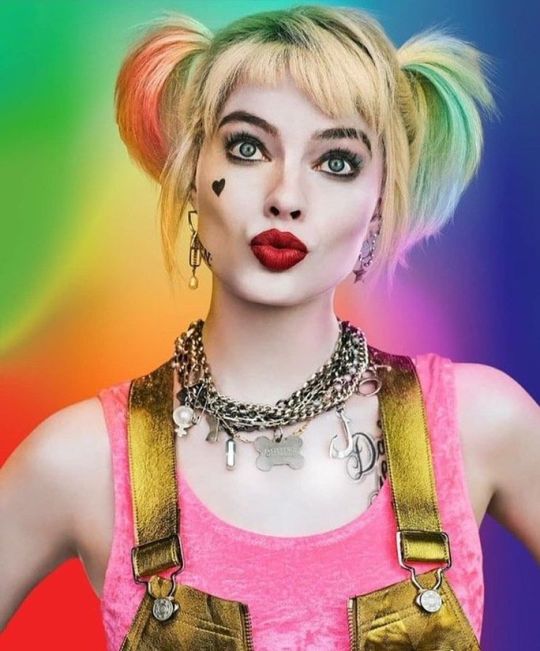
by Chris Clay
Ok-- let's get this part out of the way first: I love Harley Quinn.
Have done since her debut on Batman The Animated Series. My mother let my dad take me to see Tim Burton’s brilliant 1989 Batman film (I was 5 at the time) because she was under the assumption that Batman was always the high camp she remembered enjoying in the television show from her childhood. Thanks, Adam West! My journey into comics began shortly after learning to read with classical mythology, so I was totally prepared for all manner of tales about monsters, demons, serial killers, human traffickers, etc. Quickly becoming an avid comic reader, 10 year-old me was a DC & Marvel veteran who spent a lot of mental energy filling in the blanks on the softened-for-cartoons versions of Bats, Spidey & the X-Men.
After years of seeing "versions" of my favorite supers onscreen, I thought this new character, originally the Joker's jester henchwoman, was a breath of fresh air. She seemed like the perfect fit for both the show and the Joker, the first real Manic Pixie Dreamgirl. She was funny but also scary, vulnerable and just overall awesome. Best of all? She didn’t seem nerfed for kids tv. She just seemed oddly... real. And she was contagious. That complex reality bled onto anyone she shared enough screen time with. She helped me to see Poison Ivy as the troubled yet brilliant and sensitive person the show had always hinted she was. Besides Catwoman, no other character tested Batman's rigid sense of right and wrong more beautifully. Even Joker seemed multifaceted when Harley was around. I cheered as loudly as anyone when she ditched that clown, and those Harley/Ivy episodes were some of the best the series had to offer.
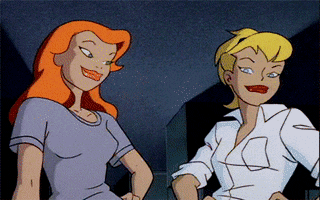
OG Harley & subsequent versions over the years tended to show a woman that was preyed upon by a master manipulator who pushed her to the edge of sanity. To the edge, not over it. She was definitely traumatized, but the original portrayals never presented any extreme mental problems. Sure, she was codependent & had a temper. And shitty taste in men. Those traits in moderation are not craaaazy. That's just being human.
Harley continued to evolve over the years, shaped by many creators and performers across multiple mediums. Her look has changed, her status as villain or antihero has vacillated and her relationships have been presented more and more as on her terms rather than something foisted upon her by chance.
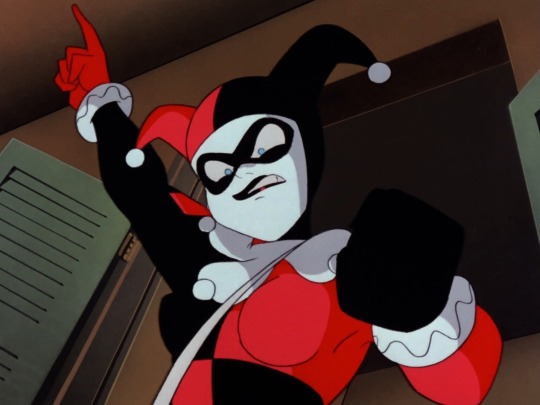
The characterization problems started in comics, but David Ayers' disappointing 2016 Suicide Squad film brought this lesser Harl to the masses, along with a version of her *ahem* more revealing New52 costume, seemingly metahuman durability & chalk white skin. I always loved the idea that Harleen had the ability to take her jester clothing & clown makeup off, sit around with an equally dressed-down Ivy and talk about who they really were, what made them tick. This new Harley (like her modern comics counterpart) was always "on", displaying very little of the soulful, mature character many of us comics & animation fans know and love. Despite that, she was definitely the highlight of the film, and there were flashes of brilliance that made me believe Margot Robbie could get to the fundamental truths of the character if given another chance.
And that brings us rather neatly to Birds of Prey (and the Fantabulous Emancipation of One Harley Quinn).
Harley Quinn, last seen in the aforementioned Suicide Squad, has just been dumped by the Joker & is forced to make her own way in Gotham City’s underworld. In short order, she meets Dinah Lance, Renee Montoya, Helena Bertinelli & Cassandra Cain. All of these ladies have, for various reasons, fallen onto the radar of neat-freak gangster Roman Sionis, played with scenery-scarfing delight by Ewan MacGregor. Forced to band together to survive, they eventually learn that despite their considerable individual talents, they're more formidable as a team.
For some reason I still can’t quite articulate, I remember being slightly underwhelmed when the cast was announced. I liked all of the actors... hell, each of them has had at least one role I absolutely loved them in-- but I still felt they were odd choices for their respective roles in this movie (more on that later). The trailer was where I got genuinely worried that Warner might be climbing back into the hole so many creators toiled to pull the DC film properties out of.
However, as I said in the beginning, I love Harley Quinn. I was definitely going to see this movie. In Margot Robbie, I felt Harley had a champion on par with Ryan Reynolds as Deadpool or Hugh Jackman as Wolverine; an actor who would work tirelessly to get their character right, on the page & onscreen, however many tries it took. Plus she was saying some interesting things about what she thought the the film & the character should represent during the rollout (and I know the movie isn't the trailer), so I was at "cautious optimism" by the time I sat down to watch the film.
I was totally wrong about one thing: the cast is the best thing about the movie, and that’s not some backhanded compliment. K.K. Barrett's production design is great, colorful while not feeling cheap or phony, and Cathy Yan has a great eye for fun directing choices that keep things zipping along... but the cast is the real MVP. They’re actually great.
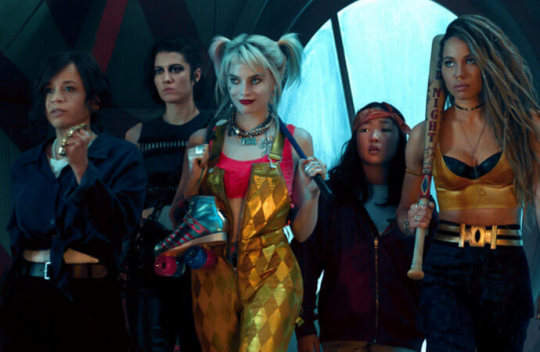
Jurnee Smollet-Bell is understated & surprisingly physical as tough-as-nails chanteuse Dinah Lance, a classic “woman trying to keep her head down in a bum situation”. She gave modern comic book moll vibes & I Stan. Rosie Perez's Renee Montoya brought a dose of realism to the candy-coated insanity swirling all around her while also giving Harley an entertaining foil for the first 2 acts. She has probably my favorite fight scene in the entire movie.
Mary Elizabeth Winstead, the person I went into the movie thinking was the most grossly miscast, is hands down my favorite character in the film. She's equal parts ruthless & socially awkward, a take on Huntress that is somehow both anachronistic & perfectly in step with her comic counterpart. Even newcomer Ella Jay Basco brings a unique charm to what could have easily been an irksome reimagining of fan favorite Cass Cain as a sassy teenage pickpocket. MacGregor’s turn as Sionis is less a character than he is a symbol, acting as a stand-in for various brands of broken maleness, but the guy’s clearly having a blast and he has decent enough chemistry with the leads. Chris Messina as Victor Vsasz is an absolute snoozefest, a waste of both character and actor that I’ll give no more space or attention.
Now for the elephant in the room: Margot Robbie's Harley is my least favorite thing about the whole movie.
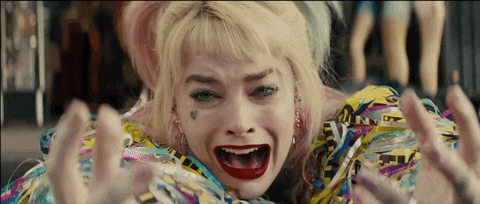
"But Chris..", I hear you yelling at your computational device, "...you said she was the lone bright spot of SS!"
True, but in a film with clever, unmuddied direction & other actors that actually display some semblance of emotion or charisma for more than one scene a piece, the bar has been raised this go round & Robbie's frantic mugging limbos under said bar by a mile. What’s worse is that she actively takes screen time that could be better spent fleshing out one of the other four characters. Only Huntress (who has probably the least screen time of any of the leads) actually has a backstory, but her origin is a large part of the plot. One could be forgiven for thinking the she wouldn’t have had one at all otherwise. We don’t really know anything about Cassandra Cain, Montoya is literally just Stock Cop, and you could make a whole movie out of how the hell Dinah ended up singing at Sionis’ club. And where the hell is the Joker?! Why is he letting Harley destabilize Gotham’s balance of power or letting Sionis threaten his ex-puddin’ while also claiming to be the the underworld’s top dog? Instead of answering these questions, we get a bunch of throwaway characters attacking the newly-emancipated Quinn and Suicide Squad flashbacks that look even uglier than before when placed side by side with the production design of this film. The fact that most of these characters are so thinly characterized yet still connect is a testament to the performances and chemistry of the central cast.
You get the feeling that a lot of this movie was Robbie as producer, exerting her ideas & energy onto a massive production that needed a lot of moving parts to line up in order to work. It's not easy to have everything riding on you, whether it’s the future of the DCEU, progressive representation of women in film or just your own movie stardom. I understand that and I sympathize. This frantic, flailing movie is the product of some 3 years of rewrites and pitching, shooting on and off for 9 months, plus all the promo stuff. Every interview that I've seen the cast do has basically been Robbie explaining things ad nauseam while Jurnee Smollet-Bell or Mary Elizabeth Winstead kind of quietly nod in agreement, with the exception of the recent season premiere of Hot Ones, where capsaicin finally allowed someone else get a word in edgewise. The real problem with that comes when you see the movie and realize she’s contextualizing so much of the film on other media outlets because the film itself doesn’t really seem to have the time or interest, leaving it’s star to try and explain what we actually see onscreen on the press tour. This leads to a situation akin to Final Fantasy XV, where the player needed heaps of supplemental content to understand what could and should have been included in the story proper. She just seems overworked, similar to when Ben Affleck wanted to perform the Herculean task of writing, directing & starring in the next solo Batman film. Maybe Margot & Harley both need a little break?
The internet is scrambling to diagnose why a well-reviewed movie starring a beloved character played by a popular actress is underperforming at the box office, citing everything from the trailer to the rating to the movie’s title, with many (including BoP creator Gerry Conway) blaming the lackluster box office on sexism, but I think there might be a simpler answer: this version is trying to pull from the entire history of Harley to create a singular characterization from sometimes disparate portrayals. It doesn’t help that Robbie’s Quinn exists in a universe that’s constantly shifting under her feet after every film.
Most comic characters are criticized for being inaccurate to the source material but Harley has arguably the opposite problem; almost a Crisis of Infinite Harleys, where Robbie and Warner Bros. want to stuff the best elements from every version of Harley into every movie she’s in. It’s supposed to be fan service but instead, often feels scattered and tiring. Not to mention the stuff these films just pluck straight out of thin air that don’t work...
The DC Universe version of the character chose to leave the Joker on her own terms and I thought that was a brilliant and socially relevant writing choice, so it was strange to then see the more mainstream (and arguably more popular) version of Harley be dragged out of Joker’s hideout, kicking and screaming. In a film who’s title was purposely made ridiculously long to accentuate the character’s supposed newfound self-sufficiency, For all of the things that do work well, Birds of Prey just doesn’t feel like what’s explicitly promised on the tin.

I still love Harley Quinn, and I still think Margot Robbie’s the right person for the job. No need to Pattinson her or anything... just put less on her plate and give the character and the movies she’s in a clear, singular direction. Pretty please, puddin’?
#birds of prey#harley quinn#dceu#margot robbie#ewan macgregor#jurnee smollett bell#rosie perez#dc comics#black mask#renee montoya#batman#ben affleck#robert pattinson#movies#essay
12 notes
·
View notes
Photo

DESCENDANTS AU MASTERPOST.
neverland.
the island of neverland, though technically not in auradon, is still a territory of it. adam acquired it in order to have access to the fairy records, but also because the island was beautiful and would be a nice addition to the other kingdoms that he had brought together under his rule. it was also meant to be a place where auradonians could get away from the mainland for some rest and recreation, but because peter and the lost boys were so hostile towards everyone who visited, the plan to build a resort and cabana there was ultimately scrapped.
neverland doesn’t abide by the “no magic” rule. the fairies of pixie hollow argued that cutting off the magic provided through the pixie dust tree could potentially upset the balance of the entire island, so they were permitted to maintain their magic on the condition that they allowed it to be siphoned from the core of neverland to help create the isle barrier. peter does not know about this.
despite magic remaining commonplace, the neverland is not what it once was. it is a lone source of raw magic in a now mostly magicless world; all of its residents (but especially those who thrive off of the belief of others) feel the effects of the lack of magical energy on the mainland. it shows through the little things, like the island’s weather not aligning with peter’s emotions / presence, or the pixie dust tree occasionally creating less dust than usual, for example.
since adam never had the opportunity to build anything in neverland, it is not up to date with technology, housing, or the latest fashion. “lost things” tend to wash up on its beaches though, and they range from tech to clothing. this causes the lost boys in particular to dress strangely, as their outfits are usually a hodge podge of items local to neverland, like furs, leaves, and twine, and random pieces from various different eras and auradonian kingdoms. people can also reach neverland by becoming lost.
there is no actual school in neverland, since peter is against the idea of schools unless it’s for pretend, but he forms “club” r.o.a.r. and tourney teams so that he and the lost boys can participate in sports after the events of d1.
peter’s characterization.
peter is aged up slightly in this verse to keep with the “teenager” theme of the series, but he is extremely immature / oblivious and is sometimes out of touch with others’ way of life (technology, slang, fashion), which usually causes a very blatant disconnect when he meets most AKs and VKs.
as mentioned previously, he is extremely hostile to any adult who comes to neverland, and his first instinct is to run them off. children and teens are permitted there, of course, regardless of whether they’re AKs or VKs, but if he dislikes them for any reason, he treats them just as he would any grown up.
when adam, belle, and fgm rounded up hook and his crew and transported them to the isle, peter actively tried to stop them. being unable to do so successfully was a massive hit to his ego, and losing hook, especially to someone that was not welcome on his island, caused him to become noticeably heartbroken for quite some time. while peter is forgetful by nature, and there are days where he doesn’t think about hook at all, he can still almost perfectly recall the memory of the banishment when reminded of it.
peter maintains his relationship with the darlings, and will occasionally travel to auradon just to visit them.
after ben becomes king, peter eventually comes to auradon from time to time, but usually sends lost boys in his place as liaisons until after the events of d3. while he still doesn’t like the idea of auradon as a whole, he likes the idea of a young king being in charge (though he doesn’t consider that ben will eventually grow up). his only disagreement with ben’s first decree is that the main focus of bringing the VKs over is to send them to school, which he hates as a rule.
peter is torn when it comes to harriet, harry, and cj, as well as any of the children of hook’s crewmen. they’re the offpsring of his enemies, as well as pirates, but they’re also young, and so he feels automatically inclined to try and ally himself with them. generally, he is fond of hook’s children in the same way that he’s fond of hook himself: he enjoys interacting with them and winding them up whenever he can, but could potentially cause them physical harm for his own amusement. * relationships will vary depending on partners / interactions.
plotlines.
before & during d1. this spans from anywhere prior to hook’s banishment up until the events of d1. peter lives in neverland and spends his days just as he did before the formation of auradon, minus constantly fighting his arch nemesis. he has no relationship with auradon; neverland’s connection to the mainland is managed exclusively by the fairies.
after d1 through d3. peter begins to make appearances in auradon city. while he rarely comes when summoned, he makes an effort to send lost boys in his place and is more lenient towards people coming to neverland.
after d3. it takes a while for word of the barrier falling to reach neverland, but when it does, peter’s primary goal is to find hook and continue where they left off.
visiting the isle. / plot only. / during one of his many frustrating attempts to try and break a hole in the isle’s barrier, peter notices a barge docking there, piled high with garbage and leftovers from auradon. before its next delivery to the isle, about a week or two later, he decides to slip aboard and rides it over to the isle of the lost and beyond the barrier, before escpaing into the derelict city in hopes of finding hook or some other incredible adventure. instead, he discovers that the island is populated with not only evil villains, but all of their children, too, and that all of the happy thoughts in the world aren’t enough to help him fly under the magic-blocking dome.
reverse isle au. / plot only. / the villains place the heroes on the isle rather than the other way around. i’ll flesh this description out with particular details later.
#masterpost.#headcanon.#verse. ( descendants. )#i'll probably update this as i go along and come up with more ideas!#do not reblog /
4 notes
·
View notes
Text
Last Stand of the Wreckers, Issue #4: This Series is Awash With Lippy Sons of Guns

Issue #4 starts off with an uncomfortably handsome Prowl. I mean honestly, look at this asshole, he’s simply too pretty.

I don’t think Roche has ever drawn the guy ugly, but this is on another level.
We’re in a flashback sequence here, as we start to gain an understanding of just why exactly Ironfist got put on the Wreckers in the first place. Back when he was working at Kimia, Ironfist got a call from Prowl. Seems Prowl’s read his work, and is impressed by the sheer amount of effort he’s put into it. They chat a bit about it, but no call with Prowl is ever casual, and he asks Ironfist if he’s ever been interested in actually being a Wrecker. Which, of course he has, but he’d never exactly been cut out for that kind of work, especially after his Accident™. Prowl has a little push in that area, because he’s Prowl, and makes a deal; Ironfist joins the Wreckers as a weapon expert, and in exchange he does something for Prowl.
We won’t find out what exactly Ironfist’s agreed to do until later, as we jump back to the present, where the Guzzle and Kup are about to lay the smackdown on some unsuspecting Decepticons.

With how many cameras are currently trained on you guys, I can’t say you really have the time for wisecracks, old-timer.
That big vault door behind them leads to the cell of one of the most notorious Autobots ever to grace the galaxy- Grimlock. This is the “help” Springer requested they find, meaning that he’s a sort of last resort, which tells you just how much of a powerhouse the guy is. Volatile, sure, but a powerhouse regardless.
Too bad the cell’s empty.
Snare steps in to explain just why that is, having snuck up on our Big Gulp duo.
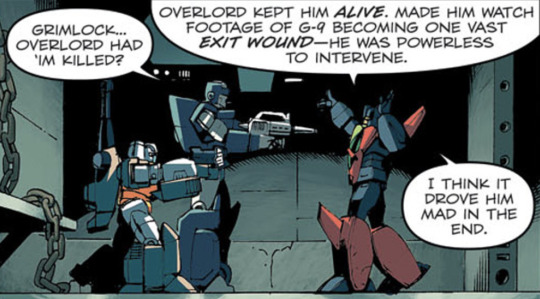
Well I’m sure that won’t be a plot point later on.
Of course, Guzzle doesn’t really feel inclined to believe a word of what this Getaway kitbash says, and starts threatening to shoot him. Snare however, has even more secrets to tell.

Perceptor and pals have finally discovered just what the hell it is that they’ve been looking for all this time. Aequitas is a supercomputer, and a massive one at that. They’re here to download its memory files. Topspin is less than pleased with this whole thing.

Ironfist agrees- there’s no way they’re going to be able to get all the data in Aequitas downloaded before the Decepticons get through to them and tear them to pieces. Verity, however, is more concerned about the size of the computer itself.
A large part of Aequitas is made up of something called a culpability drive, which breaks down factors like motivation and accountability into a streamlined equation so it can do something completely ridiculous: calculate guilt. Yes, someone had the bright idea to break down guilt into a binary system, without any “human” element involved. Because that couldn’t possibly backfire.
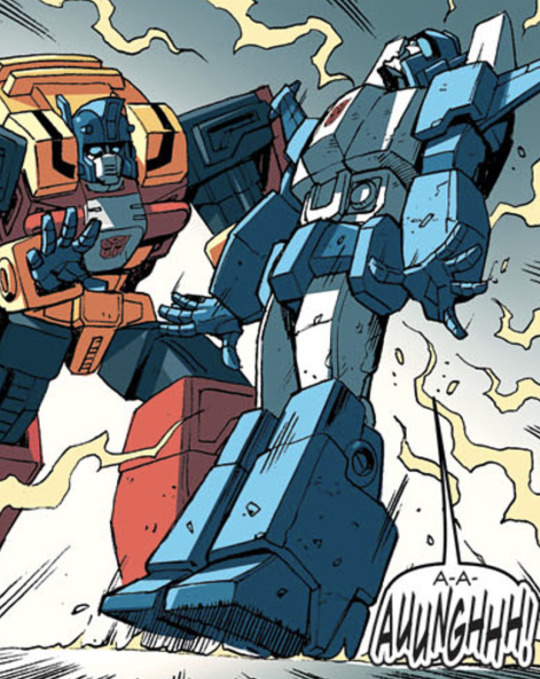
Then the narrative catches up to Topspin, and Ironfist and Verity get put on babysitting duty while he deals with his phantom pain. Pyro’s made to help Perceptor with booting up the computer.
Over with Springer, he and Impactor have a little heart-to-heart, while Twin Twist is passed out with a shadow over his face, probably waiting for the horrific reveal of what the dentist’s done to him. Springer feels really bad about Impactor having been sent to Garrus-9; he’d figured that after the trial, Impactor had been sent to rehab, or at least a prison that wasn’t quite as torturey.
Impactor points out that Springer’s testimony at Aequitas was pretty damning, and I’m starting to wonder why Springer didn’t see this coming. Unless they somehow managed to move that massive friggin’ supercomputer in the last few years, Impactor’s trial happened on Garrus-9. Kind of seems like a foregone conclusion that anyone who got put through the Aequitas wringer would end up staying if found guilty.
Impactor still doesn’t think that what he did was wrong, and the only reason they stop verbally duking it out is because Twin Twist does his dramatic face reveal and the dentist comes back in to finish off those fillings.

Funny, they had a similar setup at my old orthodontist’s.
As the dentist prepares to turn what’s left of Twin Twist’s face into the “Lust” scene from Se7en, we get back to the real point of this whole miniseries: fanwanking. Ironfist is telling Verity about the Decepticon’s answer to the Wreckers- Squadron X.
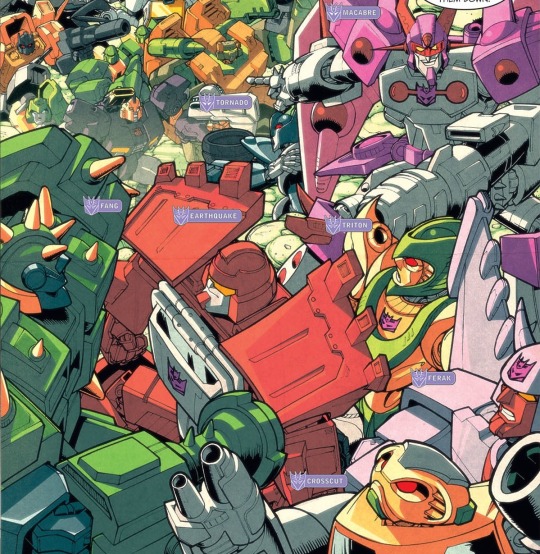
This group is made up entirely of characters who only existed in the Marvel UK comics, and even then only barely. This is convenient on multiple levels; it allows the Wreckers to have an antithesis to their own group that won’t disrupt any of the ongoing storylines outside of Last Stand of the Wreckers. Nobody’s really vying to use the guy who beat up a piano and then got thrown out of a bar, now are they?
It also allows you to use an already-established character that still has plenty of wiggle room for story application. No point in trying to make a new set of characters when we’ve got a bin full of nobodies off in the corner. Especially when we’re only going to have these guys around for a few minutes.
But we’ll get to that later.
Back to Ironfist’s story…

Oh hey Whirl.
Springer’s in a bit of a pickle- his lower half is trapped under a busted barricade, and Squadron X is closing in. Impactor has no intention of leaving Springer behind, so it’s time to get crazy. Springer tells Impactor to blast a hole through his TORSO so he can surprise-attack the approaching enemy. Impactor does so, reluctantly.
Please note that the emphasis is not mine, but the narrative’s.
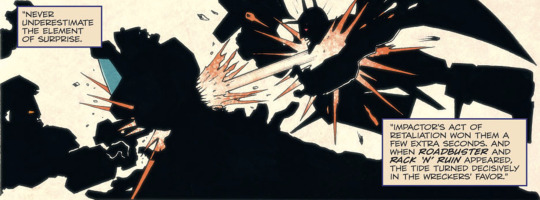
That’s just a cool panel.
Once all that’s over and done with, Squadron X are all put into inhibitor harnesses to keep them from trying anything funny while in custody. But oh ho, what’s this? They’ve escaped! And they’ve ripped Sandstorm’s arm off! Surely, this must be dealt with, and who better suited for the job than the dude who’s been obsessed with taking these guys out for years now? Impactor gets to work.

And thus the day is saved, thanks to the Wreckers! Yaaay!
With Ironfist’s story concluded, Perceptor takes the time to mention that they’ve got a problem. Turns out Aequitas has some state-of-the-art security measures going on- in order to even turn the thing on, someone’s got to feed the thing their spark. You know, a robot soul. This thing runs on souls, and the donator has to be a willing participant otherwise it won’t work.
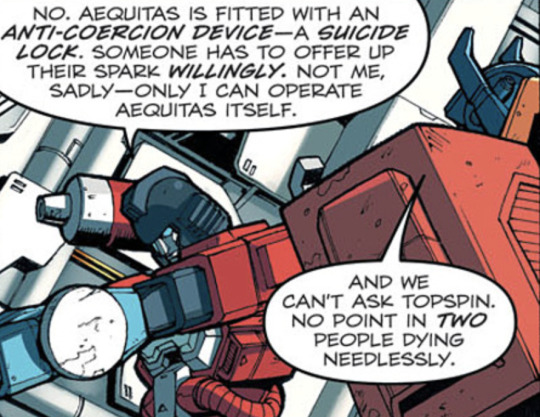
Well that’s awful convenient for you, now ain’t it, Percy?
I’m assuming they just never turned the thing off during the trials, otherwise they would have run out of juice very quickly.
So it’s slim pickings in terms of sparks. Perceptor’s playing IT, Topspin’s whole spark situation is a consent minefield, and Verity’s soul is the normal, human, intangible kind. And now we get to the part of our story that’s a little sad.
Pyro and Ironfist aren’t popular. They’ve never been in the spotlight. They aren’t important. They were brought on the Wreckers to die, plain and simple, because it’s a game of numbers, and their numbers are miles below the likes of Springer and Kup.
Pyro isn’t on-board with this at all, saying that this isn’t how it’s supposed to go down for him.

Say what you will about his delusions of grandeur, but this is a guy who knows what he wants.
While Pyro’s dreaming big, Topspin’s having a really bad time in the background. That vicarious perception’s hitting real hard right now.
Ironfist plays the child in a bitter divorce between Pyro and Verity as they argue over who the hell should die so the plot can keep moving. Ironfist has a lot to say, a lot that he really should say, but he doesn’t. He’s not proud of himself, or the things he’s done as a weapons’ expert. After reflecting on his life- a life that hasn’t been profoundly wondrous or meaningful- he concedes to being the one to die.
But that doesn’t happen, because Topspin takes matters into his own hands and puts the goddamn dog to sleep. The dog in this case being himself and Twin Twist. Aequitas thanks him for his donation, sucks out his spark, and over in the torture chamber Twin Twist explodes.
With the twins(?) dead, Aequitas is online, and not a moment too soon, because those Decepticons are starting to bring the door down. Perceptor hands a headphone jack to Ironfist, tells him to plug it into his brain, and to get ready for the hurt, because they’re about to download the entirety of this supercomputer into his head.
Back with Impactor, he’s about to get his cornea scratched, when Guzzle and Kup come to save the day, following Snare’s guidance.
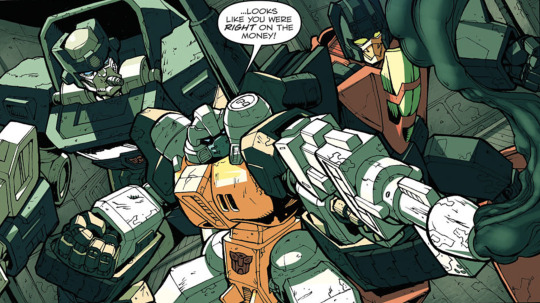
I just want to say, Guzzle wins the Worst Crotch award. It’s simply awful.
So Kup and Guzzle free Springer and Impactor, just in time for Springer to revenge-stab the dentist with the torture stick. Too bad he’s already shot Snare.
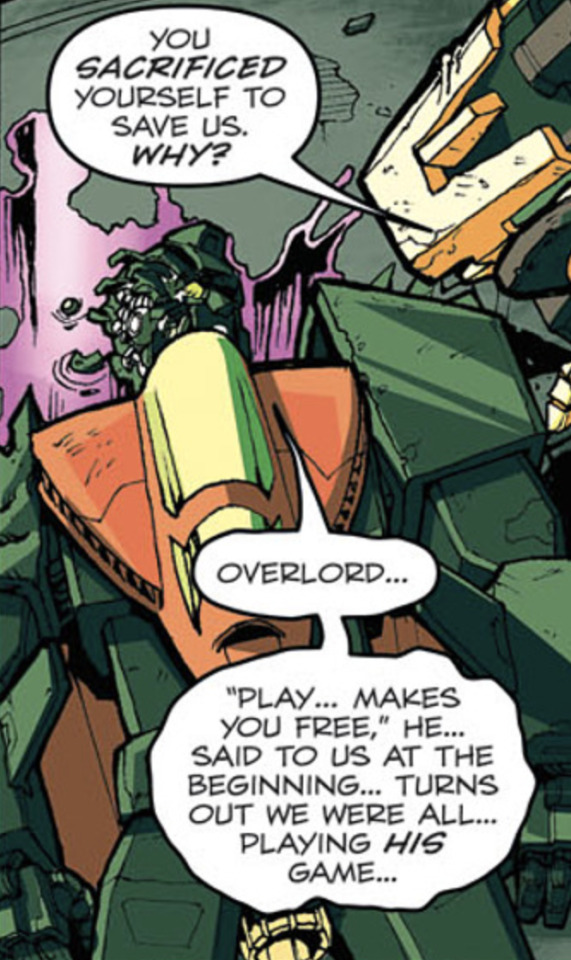
Play… makes you free... in the prison that’s been turned into basically a death camp. Is… are we really doing the Holocaust parallels again? God, I hope I’m reading too much into that, I really do.
We finally find out what the prize for winning the Pit fights is: you can either fight Overlord, or kill yourself. Not much of a prize, if you ask me.
Speaking of the Blue Terror, he’s on his way over. Snare asks that Impactor just kill him, because there’s no way he’s going to risk being found out by Overlord that he was being sneaky. Impactor obliges, crushing his brain module between his fingers.
Then Overlord quite literally explodes into the room.
Back over in the Aequitas chamber, Ironfist’s just finished with his upload, and he’s shaken by what he now knows. The Decepticons have nearly broken down the door at this point, and there’s only one way to save themselves- they have to detonate the prisoners’ deterrence chips. This, of course, includes Impactor. Perceptor’s all for it, but Pyro’s wholly against the idea. Verity tries to put in her vote, but humans don’t have rights in the eyes of Wrecker law, so it all comes down to Ironfist.

You heard the man, let’s kill the purple guy.
#transformers#jro#last stand of the wreckers#issue 4#maccadam#Hannzreads#text post#long post#comic script writing#wreckers trilogy
33 notes
·
View notes